
© 2017 The Association for Water and Rural Development
RESILIM-O:
Resilience in the Limpopo Basin
Program–Olifants
MILESTONE 6: Progress Report #5:
Under the
Lower Olifants catchment
Agricultural Support Initiative
(AgriSI)
30/09/2017

MILESTONE 6: PROGRESS REPORT #5:
| 2
Acknowledgements
The USAID: RESILIM-O project is funded by the U.S. Agency for International Development under
USAID/Southern Africa RESILIENCE IN THE LIMPOPO BASIN PROGRAM (RESILIM). The RESILIM-O project is
implemented by the Association for Water and Rural Development (AWARD), in collaboration with
partners. Cooperative Agreement nr AID-674-A-13-00008.
© Association for Water and Rural Development (AWARD)
P O Box 1919
Hoedspruit 1380
Limpopo, South Africa
T 015-793 0503
W award.org.za
Company Reg. No. 98/03011/08
Non-profit org. Reg. No. 006 –821

MILESTONE 6: PROGRESS REPORT #5:
| 3
ABOUT USAID: RESILIM
USAID’s Resilience in the Limpopo River Basin (RESILIM) program addresses ongoing degradation in the
Limpopo River Basin in southern Africa, where people face water shortages, increased floods, and declines
in crop productivity as climate change further stresses an already water limited region.
There are two components to the program; one operating at a basin-scale (RESILIM-B, which is
implemented by USA-based Chemonix and addresses similar issues at the scale of the four SADC member
states that share the Limpopo Basin (South Africa, Botswana, Zimbabwe and Mozambique) and a
catchment-scale project (RESILIM-O) that It is being implemented by the Association for Water and Rural
Development (AWARD). Both projects share the same overall objectives. You can find out more
information on the RESILIM projects on www.usaid.gov websiteand www.award.org.za.
The USAID’s RESILIM-O focusses on the Olifants catchment. The program aims to reduce the vulnerability
of people and ecosystems in the Olifants Catchment specifically, by improving how transboundary natural
resources are managed. By understanding the systemic causes of vulnerability, including climate
vulnerability, it is promoting new ways of thinking and acting to promote integrated water and
biodiversity management.
ABOUT AWARD
At AWARD, we recognize that the natural world’s resources are limited, and undergoing rapid depletion
and transformation. We know current practices of useand management are inadequate to deal with the
changes and challenges we are facing. We design practical interventions to address the vulnerability of
people and ecosystems, and merge considerations from both environmental and social perspectives. Our
approach involves thinking across disciplines, boundaries and systems.
We are working with diverse people and institutions in the water and biodiversity sectors in the Olifants
River Catchment to understand the multiple vulnerabilities to change, including climate change. Along
with quality scientific contributions, our engagement in the socio-political context of the Olifants River
Catchment allows us begin to begin to institutionalize integrated, resilience-based practices, providing a
foundation for robust development policy and practice in the in this river catchment, and beyond.
The Olifants Catchment: An overview
The Olifants River Catchment falls within the Limpopo River Basin, which is part of an international
drainage basin that stretches across South Africa, Mozambique, Zimbabwe and Botswana. In fact, the
Olifants River contributes nearly 40% of the water that flows in the Limpopo River making it an important
catchment in the system as a whole.

MILESTONE 6: PROGRESS REPORT #5:
| 4
At the heart of this catchment is the Olifants River, a vital artery that flows for 560 kilometres through
South Africa and into Mozambique, where it is known as the Rio dos Elefantes in Mozambique.
This mighty river originates in South Africa’s Mpumalanga Highveld, flowing northwards before curving in
an easterly direction through the Kruger National Park and into Mozambique, finally finding rest in the
salty water of the Indian Ocean near Xai Xai, just north of Maputo.
The main tributaries of the Olifants River are the Wilge, Elands, Ga-Selati, Klein Olifants, Steelpoort,
Blyde, Klaserie and Timbavati Rivers.
Along with its tributaries, it is one of the six major Lowveld river systems, occupying an area just short of
55 000 square kilometres. It traverses three provinces in South Africa; Gauteng, Mpumalanga and Limpopo.
About 3.5 million people live on the South African side of the catchment. In Mozambique, it flows through
Gaza Province, which is home to about 700 000 people.
A system under change
Our catchment is the foundation of our livelihoods and development. Yet the river and associated natural
resources in the Olifants Catchment are under threat...
Unchecked pollution, inappropriate land resource use, weak and poorly enforced policies and regulations
and poor protection of habitats and biodiversity are degrading the Olifants at an alarming rate. What’s
more, the area is however under threat from factors such as mining for heavy metals, inappropriate land
management, rural sprawl and unsustainable use of natural resources. This affects the level of goods and
services provided by the ecosystem.
The diverse population groups living in the Olifants Catchment all have one thing in common; they rely on
the river and the catchment’s natural biodiversity for their livelihoods. This reliance can be direct or
indirect. Rural communities rely on it for things such as traditional medicine, grazing and browse, fuel,
food and housing materials. Some people in river-side communities harvest reeds, collect water from the
river for washing and drinking and useit for recreational and spiritual practices. Subsistence farmers in

MILESTONE 6: PROGRESS REPORT #5:
| 5
Mozambique rely heaving on the catchment’s flood plains. There are also large mines and associated
industries, large scale agriculture and the wildlife economy, which all rely on a healthy, functioning river
system. Often people forget that what they do upstream affects people down stream, sometimes with dire
consequences.
The catchment is our home and it is worth investing in its future. The work reported here is part of the
ongoing activities of the RESILIM- O project under the grant from USAID: Southern Africa.

MILESTONE 6: PROGRESS REPORT #5:
| 6
Project partners
Mahlatini Development Foundation (MDF) is a small public benefit non-profit organization consisting of
rural development practitioners who specialize in participatory learning and action processes, sustainable
natural resource management and low external input farming systems, including a focus on rain water
harvesting, conservation agriculture, intensive homestead food production, food security, micro finance
and enterprise development.
MDF designs and implements rural development programmes and training processes providing learning
processes for adults all the way from semi- literate farmers to post graduate university level. We work in
partnership with government and non-government organisations alike. We are sensitive to and mainstream
where possible gender, disability and living with HIV/AIDs

MILESTONE 6: PROGRESS REPORT #5:
| 7
Contents
Table of Contents
1 Executive Summary .........................................................................................................9
1.1 Progress for the reporting period...................................................................................9
2 Project Objectives ..........................................................................................................9
2.1 Overview of RESILIM-O Project objectives.........................................................................9
2.2 Sub-grant Project Objectives ...................................................................................... 10
3 Milestone Description..................................................................................................... 10
3.1 Definition of milestone and purpose.............................................................................. 10
4 Approach/ Process/ Activities.......................................................................................... 12
4.1 Summary of activities ............................................................................................... 12
4.2 Progress and Results.................................................................................................13
4.2.1 Learning and mentoring.........................................................................13
4.2.2 Learning workshops...............................................................................18
4.2.3 Garden monitoring................................................................................20
4.2.4 Collaborative work...............................................................................25
4.3 Success and Challenges in meeting milestone. .................................................................31
4.4 MERL.................................................................................................................... 31
4.4.1 Indicators: Assessment September 2017......................................................31
4.4.2 Project Life Change Questions:.................................................................32
4.4.3 Work Plan for the coming three months.......................................................34
4.5 Communication Materials from this milestone..................................................................35
4.6 Other outputs......................................................................................................... 35
5 Overall Progress of Project.............................................................................................. 35
5.1 Integration of milestone status.................................................................................... 35
5.2 Project risk and mitigation summary............................................................................. 36
5.2.1 Implementation risks and mitigation..........................................................36
5.2.2 Financial risks and mitigation...................................................................37
6 Conclusion and Recommendations..................................................................................... 37
7 Appendices................................................................................................................. 37
1Appendix 1: Case studies; WRC CCA............................................................................... 38
1.1Climate Change Adaptation, Limpopo....................................................................... 38
1.1.1Description of the programme..............................................................38

MILESTONE 6: PROGRESS REPORT #5:
| 8
1.1.2Problem ........................................................................................38
1.1.3Rationale .......................................................................................39
1.1.4Implementation of practices................................................................39
1.1.5Methodology ...................................................................................43
1.1.6Outcomes and learnings......................................................................45
Future planning........................................................................................................... 49
1.1.7Suitability of this community as an implementation site for the CSA project.......50
2Appendix 2: DICLAD_Conversations about farming and climate change_ Principles for good farming
practices –Sedawa 20170817.............................................................................................. 51
2.1Agenda ............................................................................................................ 51
2.2Introduction ...................................................................................................... 51
2.3Climate Change Concepts...................................................................................... 53
2.4Small group work................................................................................................ 53
2.5Way forward...................................................................................................... 56

MILESTONE 6: PROGRESS REPORT #5:
| 9
1Executive Summary
1.1Progress for the reporting period
During this quarter focus was given to:
•The construction of the 10 tunnels (shade cloth structures and associated drip irrigation systems)
across three villages –Botshabelo, Swedawa and The Oaks
•The construction of 3 underground RWH storage tanks (24m3) in Botshabelo and Sedawa–Norah
Mhlaku, Christina Thobejane and Mariam Malepe.
•Training and mentoring of Local Facilitators (LFs) and garden monitoring for participants
In addition, DICLAD workshops have been held for exploration of Climate Change impacts and adaptation
for all 6 villages (3workshops).
Further learning workshops have been run for all 6 villages, to provide an overview of all the practices
introduced thus far, a further focus on natural pest and disease control and to start on the Conservation
Agriculture trial process for the coming planting season. The agendas have been designed to accommodate
learning needs expressed by the groups. Some areas, for example Sedawa have asked for another process
around natural pest and disease control. Willows and The Oaks have requested an emphasis on practices
appropriate for field scale implementation.
Attention has been given to support the local facilitators in their processes of providing advice and
support to participants and in completion of the garden monitoring forms. A total of 38forms have bene
translated and analysed (April- July 2017). This process is ongoing and some adjustments have been made
to increase efficiency.
PARTICIPANTS THIS PERIOD
SEEDS OF LIGHT: Trygive Nxumalo
MAHLATHINI: Erna Kruger, Sylvester Selala, Chris Stimie
AWARD: Richard Hatfield, Bigboy Mkhabela,
2Project Objectives
2.1Overview of RESILIM-O Project objectives
RESILIM-O is large multi-faceted, multi-stakeholder, cross-boundary programme to reduce vulnerability to
climate change through building improved transboundary water and biodiversity governance and
management of the Olifants Basin through the adoption of science-based strategies that enhance the
resilience of its people and ecosystems through systemic and social learning approaches. The programme
has been running for four years and is being implemented byAWARD (The Association for Water and Rural
Development) with funding from USAID.
The Agricultural Support Initiative (AgriSI) was initiated as a sub-grant process within the larger
programmed towards the end of 2016. This initiative works specifically with climate change adaptation
processes with smallholder communities in the lower Olifants River basin. It is being implemented jointly
by Mahlathini Development Foundation and AWARD.
The Agricultural Support Initiative (AgriSI) addresses two of the RESILIM-O programme objectives directly:

MILESTONE 6: PROGRESS REPORT #5:
| 10
i. To institutionalize systemic, collaborative planning and action for resilience of ecosystems and
associated livelihoods through enhancing the capacity of stakeholders to sustainably manage natural
resources of the Olifants River Basin under different scenarios
ii. To reduce vulnerability to climate change and other factors by supporting collective action, informed
adaptation strategies and practices and tenable institutional arrangements.
2.2Sub-grant Project Objectives
Sound agro-ecological practices for soil and water conservation (SWC) and the ability to self-organise and
act collectively are regarded as fundamental for building adaptive capacity and resilience. Not only do
agro-ecological farming approaches require minimum external inputs –which may be expensive and
increase dependency if subsidised – but they foster farmers’ sense that they can build sustainable futures
from local inputs and efforts. With knowledge about the potential impacts of climate change included in
the learning journey, farmers can make purposeful decisions around practices such as seed and crop-type.
This approach supports livelihood diversification –also fundamental for increased resilience –through
‘value-added’ associated activities such as seedling production, tree nurseries and bee-keeping.
The overall aim of the Agricultural Support Initiative is to enhance the resilience of the people and
ecosystems in selected villages(5-6) in the Lower Olifants River basin, using a systemic social learning
approach, exploring the question:What are you learning about the socio-economic and biophysical
characteristics of your environment and how these are changing and how are you ableto respond to that?
The overarching objective of this work is to provide support for increased adaptive capacity and resilience
to the effects of climate change for households involved in agriculture in select communities of the
Olifants River Catchment through:
-Improved soil and water conservation and agro-ecological practices for increased food security
-Livelihood diversification and supplementation through alternative climate resistant production;
-Increased community empowerment as a result of self-organisation and collective action.
3Milestone Description
3.1Definition of milestone and purpose
Each milestone and progress report indicates activities under the broad themes of learning and mentoring,
introduction to innovations and experimentation, collaborative work and networking undertaken during
the reporting period.
The table below summarises these activities against the milestone and indicate achievement of these
milestones.
Table 1: Summary of deliverable completion under Milestone 5: April- June 2017

MILESTONE 6: PROGRESS REPORT #5:
| 11
Activities
planned
Completed?
Expected
outcomes
Completed?
Verification
documenta
tion
Completed?
Reference
Learning &
Mentoring:
In all 6
communitie
s each 2
days
Learning &
Mentoring:
Local Facilitator
training
Local Facilitator
mentoring of
new practices
Farmer ongoing
self-monitoring,
-assessment and
learning
C
-Training of LFs in
mentoring, learning
and monitoring ( 2
days x 6 villages)
-LF’s undertake
garden mentoring
and monitoring with
farmers (3-4 days
ea), supported by
field team-
-Learning groups;
learning sessions –
overview of
practices- natural
P&D control, tower
gardens, CA
C
C
C
Progress report on
outcomes
including the
following
documentation:
1. Photos & photo
diaries
2. Farmer work
plans
3. Garden
monitoring
4. Monthly
assessments
5. Monitoring
forms
6. Cluster activity
records
7. Event
materials,
attendance
registers
C
1. Photos in reports
and–All photos
saved in directories
and kept by Erna
and Lenkie
2.Farmer work
plans are recorded
in the garden
monitoring forms
3. 38 Garden
monitoring forms
across five villages
4. In this report
5. 36 garden
monitoring forms
6.Appended to this
report
7.Appended to this
report
Intro to
innovations
and
experiment
ation: In all
6
communitie
s each 2
days
Mentoring by
trainers and LFs’
C
- Garden monitoring
including trainers and
LFs- all participants
visited at least once
by LFs and a garden
monitoring form
completed
C
C
Collaborativ
e work: In
all 6
communitie
s each 2
days
Site assessments
and community
contributions to
infrastructure
support; tunnels,
drip kits and
RWH storage
tanks
C
-Preparation for and
construction of
tunnels (x10) and
RWH storage tanks
(x3) complete.
C
C
Networking:
1. Local
facilitator
networking:
all 6
Memetje
villages
reps
2. Village 3
(Oaks) &
village 4
(Lepelle)
open days
(1 day
each)
DICLAD
workshops
(Sedawa,
Botshabelo,
Willows and The
Oaks, Finale and
Lepelle
C
- 3 DICLAD workshops
exploring CC impacts
and adaptation
options
C
C

MILESTONE 6: PROGRESS REPORT #5:
| 12
4Approach/ Process/ Activities
4.1Summary of activities
This section gives an indication of activities undertaken during the reporting period to achieve the
outcomes for this period, time spent and people involved.
Table 2: Summary of activities for the reporting period July-September 2017.
DATE
DESCRIPTION OF ACTIVITY
Time
WHO WAS
INVOLVED
2017/07/06-07
Reports, arrangements for workshops
2 days
Sylvester –1
day
2017/07/05-07
Baseline questionnaires database
3 days
Erna
2017/07/05
Trygive planning at AWARD office
1 day
Trygive
2017/07/07
Household garden monitoring with BB, Lenki, Happy at
Botshabelo, Mammestsa
1 day
Trygive
2017/07/20,21
Follow up meeting Christina at sedawe, Norah in
Mametja, Merriam Botshabelo. Follow up On building of
pits for tanks, Christina at Sedawe, Norah in Mametja,
Merriam Btshabelo
2 days
Trygive
2017/07/23-29
Week in Hoedspruit- tunnel and tank construction, hh
visits
7 days
Sylvester
2017/07/25,26
Building tunnel at Meriam with Sylvester in Botshabelo.
Indaba on Climate change Maruleng Municipality
2 days
Trygive
2017/07/31-
08/06
Dam construction with Chris Stimie and Southern
Irrigation team
7 days
Sylvester, Chris
2017/07/25
RWH DKA report and invoice
1 day
Erna
2017/07/28-29
AgSi case study for implementation review (5 fingers)
1 day
Erna
2017/08/01-02
Database for baseline questionnaires and monitoring
forms –started
2 days
Erna
2017/08/14
Logistics around RHW tank sites and prep for tunnel
construction
1 day
Sylvester
2017/08/15
Visit to LFs
1 day
Sylvester
2017/08/16
Construction of tunnel, Sedawa
1 day
Sylvester
2017/08/17
DIClAD workshop Sedawa
1 day
Sylvester
2017/08/18
DIClAD workshop Lepelle (cancelled) Logistics
Botshabelo + Sedawa
1 day
Sylvester
2017/08/19
Travel to PMB
1 day
Sylvester
2017/08/14-19
Visits to LFs; Willows, Oaks, Sedawa. Finance meeting
with Julia, Mayford, DICLAD prep and DICLAD w/s
Sedawa, Lepelle,
6,5 days
Erna
2017/08/21-26
Chris Stimie, Southern Irrigation team -finalisation of
underground RWH tanks
6 days
Chris
2017/09/18-19
Workshop in Willows
2 days
Sylvester
2017/09/20
Visits to LFs
1 day
Sylvester
2017/09/21
Workshop in The Oaks
1 day
Sylvester
2017/09/22, 25
Garden monitoring
4 days
Sylvester
2017/09/26,
27,29
Workshop Sedawa, Lepelle, Botshabelo
3 days
Sylvester
2017/09/28
DICLAD Workshop –at the Oaks
1 day
Sylvester
2017/09/30
Travel, reporting
2 days
Syvlester
2017/09/13-15
Milestone report
3 days
Erna

MILESTONE 6: PROGRESS REPORT #5:
| 13
2017/09/28-30
Milestone report- garden monitoring consolidation
3 days
Erna
Sylvester: 36 days, Erna: 20 days, Chris: 10 days, Trygive 6 days
4.2Progress and Results
4.2.1Learning and mentoring
This quarter was devoted mainly to working with the Local Facilitators (LFs)to do the household visits and
garden monitoring for learning group participants.
An implementation summary of this process is provided below.
4.2.1.1LOCAL FACILTATOR ACTIVITIES AND PROGRESS
Below are a selection of photographs showing the Local facilitators in action
Above Left to right: Melida Shaai and Tomspon Motseo from Willows in an LF meeting, showing the seeds to be
distributed for spring planting. Mr Motseo in his garden next to one of the trench beds he is making and Christina
Thobejane from Sedawa showing some of her produce being harvested.

MILESTONE 6: PROGRESS REPORT #5:
| 14
Above left and right: Florence Lewele from the Oaks working in a small group with a garden monitoring form to
interview a participant. Josias Seboyane and Patricia Ngobeni from Lepelle show a participant how to mulch her
furrows and ridges during a household visit.
4.2.1.1.1 Progress summary
Nine Local facilitators have been selected, instead of the original six planned for. This is due to distances
between villages, sizes of the groups (1 LF per 25 learning group members), gender requirements and
limited skill sets for these facilitators.
Formal terms of employment have not been agreed to with the LFs’, and their payment is seen as stipends
supporting their activities. Each, fills in a detailed timesheet of their activities per month up to a
maximum of 10 days (@R200/day). Activities for LFs’ include:
➢Monitoring implementation in participants’ gardens on a regular basis, using the gardening
monitoring forms provided. It is expected that LFs can visit 3 participants per day.
➢Assistance to individuals intheir gardening practices by providing advice, doing small
demonstrations and assisting in setting up gardening experiments. It is expected that LFs will help
in doing some of the work required
➢Set up small localised training events where required.
➢Providing a link between the implementation organisation and the participants in helping to set up
meetings for example or in distribution of seeds as well as raising requests and issues from the
participants with the implementing organisation. Keeping lists of participants’’ names and helping
new participants integrate into the learning group.
It was expected that most of the LFs’ time would be devoted to doing regular gardening monitoring visits.
Because the groups are in fact still quite fluid with new members coming and going, they have had to
spend more time on induction of new members and introducing new practices to them as well as those
who had not attended some of the training/learning sessions for the group. This requires considerable
awareness raising and facilitation skills, which some of the LFs are excelling at, but others are not. This
means that some of the learning groups are expanding quite rapidly, while others are shrinking at a rather
alarming rate. The intention was not for the LFs to managethe learning groups in this way, but this
aspect of their role has somehow been accentuated; partly due to an assumption on our part that the
learning group membership is reasonably stable and partly due to the LFs taking on this management
process as part of their “jobs”. There has been a strong and unexpected trend for the LFs to attempt to
ensure that they maximise their activities to the maximum time of 10 days and they have thus taken on
roles that were not expected of them.
Most of the LFs have a reasonable understanding of the practices they are promoting, but a number of
them are trying to ‘force” the participants to implement these practices. This has also been a bit
unexpected and doesn’t fit into the ambit of their negotiated roles. It has also led to some conflict
between the facilitators and the learning group members.
These issues are being worked through by having intensive one on one mentoring sessions with each LF.
An aspect of this process is to look for ways to re-invigorate the failing learning groups. This would mean
re-introducing some trainings, finding ways to include those working in fields rather than at homestead
level, re introducing the idea in the villages using different entry points such as the clinics and home
based care workers and working with schools where appropriate.
Another major difficulty for them has been the extreme water shortages in their villages; specifically
Botshabelo, Sedawa, Willows and Finala. There literally are no options for irrigation for most of the
participants, who are paying for small quantities of household water, often needing to transport it in
drums from the distribution points. Those that have boreholes or have managed to make some kind of
arrangement for tapping into the municipal water lines are the only ones who can irrigate. Participants
cannot pay for irrigation water.
4.2.1.2Village levels summaries

MILESTONE 6: PROGRESS REPORT #5:
| 15
Table 3: Summary of implementation by the Local facilitators; September 2017
Village
LFs
group
size
New
HH
Active
hh
Practices
promoted
Activities
Comments
Sedawa
Christina
Thobejane
Alex
Makgopo
51
11
~30-35
*Greywater
management
*mulching
*pest control
remedies
*soil fertility
improvement
*Liquid manure
*drip kits
*check soil
erosion and
control, eg
stone bunds,
diversion
ditches
*trench beds
(shallow and
deep)
*mixed cropping
*5 Fingers
assessment
*Saving water
*eco circles
*farmer
experimentation
*Garden
monitoring
*Small group
trainings and
follow up support
*garden level
advice and small
demonstrations of
practices
* Brining on board
new participants
*Distribution of
seeds
* Support for new
innovation
construction
processes;
tunnels and RWH
tanks
*
*Garden monitoring has been
done together
*12 forms filled to date
*A local training conducted in
Mametje (Mabins A) has led to
a subgroup of 16 participants
there learning and working
together –meeting monthly
*Another new group has
requested entry (close to the
turn off at the hardware store)
*1 new volunteer for RWH
tanks supported
* There are severe water
shortages
Willows
Melida
Shaai
Tomson
Motsiea
40
11
~10-15
*Greywater
management
*mulching
*pest control
remedies
*soil fertility
improvement
*drip kits
*diversion
ditches
*trench beds
(shallow and
deep)
*eco circles
*Mixed cropping
*Good irrigation
practices
* furrows and
ridges on
contour
*farmer
experimentation
*Garden
monitoring
*garden level
advice and small
demonstrations of
practices
* Bringing on
board new
participants
*Distribution of
seeds
* Garden monitoring has been
done together
*1o forms filled to date
*Seeds distribution manged
well, with follow up on
planting
* Difficulty with motivation of
members and many have
withdrawn
* Requested another training
from MDF
*There are those who work in
the fields not their households
and believe these practices
are not for them
*There are severe water
shortages in the village
Oaks,
Finala
Florence
Lewelle
10
2
8
*mixed cropping
*mulching
* garden layout
*Liquid manure-
plant based
*trench beds
(deep and
shallow)
*CA
*Garden
monitoring
*garden level
advice and small
demonstrations of
practices
* Bringing on
board new
participants
*Distribution of
seeds
*7 forms filled to date- but not
done well
*Garden monitoring attempted
but participants often not
home. She does not have their
contact details
*Quite a number of original
learning group members have
lost interest or resigned
*Linkage made with the local
school- but no interest shown
There are those who work in
the fields not their households
and believe these practices
are not for them
*There are water shortages in
the village –but not as severe
as in other places.

MILESTONE 6: PROGRESS REPORT #5:
| 16
*She requested support from
Lenkie and another training
session run by MDF
Lepelle
Patricia
Ngobeni,
Josias
Seboyane
11
11
*mixed cropping
*mulching
* garden layout
*Liquid manure-
plant based
*trench beds
(deep and
shallow)
* natural pest
and disease
control
*CA
*Garden
monitoring
*Garden level
advice
*Distribution of
seeds
*5 forms filled to date
*LFs not practising many of
the methods and thus do not
demonstrate them well to
participants.
*Particpants have worked in
and expanded their gardens.
Materials for packing trench
beds is a challenge
*Seed was distributed to
specific individuals in the
learning group to grow as
seedlings and distribute; rape,
chinese cabbage, green
pepper, swiss chard, chilli,
marigold, parsley, coriander,
beans
*Seedling production and
distribution has not happened
as planned- in future seeds to
be given directly to
participants
*Linkage made with the local
school-
Botshabelo
Mariam
Makghobo
28
4
10
*Greywater
management
*mulching
*pest control
remedies
*soil fertility
improvement
*Liquid manure
*drip kits,
tunnels
*check soil
erosion and
control, eg
stone bunds,
diversion
ditches
*trench beds
(shallow and
deep)
*mixed cropping
*eco circles
*Garden
monitoring
*garden level
advice and small
demonstrations of
practices
* Bringing on
board new
participants
*Distribution of
seeds
*Monitoring conducted with
support as Mariam is not
literate. –
*Some practices not focussed
on as the LF is not using them
and has forgotten
*Focus in this quarter on
tunnel construction and
underground RWH tanks.
*Seed distribution done and
seedling production by
participants undertaken
4.2.1.3Promotion of good practices
Some of the practices and processes introduced in the learning workshops are being promoted well. These
include:
•Mulching
•Mixed cropping
•Trench beds
•Pest control remedies
•Eco-circles
Some practices have not been internalised all that well and are difficult to implement:
•Soil erosion control
•Diversion ditches
•Nurseries
•Seed saving of new varieties and crops introduced
•Promotion of herbs and multi-functional plant species

MILESTONE 6: PROGRESS REPORT #5:
| 17
Some practices have been under-emphasised or not well remembered
•Liquid manure
•Bucket filter for greywater
•Contours and placing furrows and ditches on contour
4.2.1.4Monitoring forms
LFs are struggling to do these individually. For the mostpart, they have gone as a team of 2 to fill in these
forms. They have bee unsure about filling in forms for participants who are not doing much, or have not
implemented the new practices. They have also been unsure about recording of garden monitoring for
follow up visits, finding the present forms quite long –sometimes not much has changed –or there are
only 1-2 small changes and it seems too much to have to fill in the whole form again.
A decision was made to make a simplified garden monitoring follow-up visit form to
accommodate for this.
Generally, LFs’ have claimed for 10 days/month of house hold visits and support. The number of forms
filled in for participants do not tally with these and there appears to be a trend for LFs to spend time, so
as to be able to claim.
It was emphasised to LFs that they are expected to do at least 3 hh visits in a day and thus three
forms. If their group is small then they cannot claim for a lot of time. They will be paid for forms
completed and submitted- not just visits.
4.2.1.5Overall trends
•Where LFs have got the process right of working with participants and promoting farmer
experimentation the support has worked well –for example in Sedawa. Where they have however
tried to ‘force’ participants to implement the practices introduced, there has been some
resistance - for example Willows and The Oaks. Some of the LFs are seeing themselves as being in
charge of the learning groups and this is not leading to good cooperation.
•LFs’ holding small workshops around specific themes in small sub groups within their village has
worked well. This has led to a considerable expansion of the learning group in Sedawa for example
and also to learning group members undertaking to meet regularly and discuss their issues.
•There is an expectation from participants that LFs will help them to do the work of
implementation. Although this has been emphasised by the facilitation team as a good thing, LFs
are not keen to actually work in participants’’ gardens.
•Not all the LFs’ are practising the whole suite of methods and processes introduced during the
learning processes and as a result what they are promoting to their learning group members is
biased more towards what they are doing and are familiar with.
•Generally the garden monitoring forms have been difficult for LFs to complete and have not been
done well, despite training sessions and mentored practice rounds with the facilitators.
•LFs have all set up good working systems with the participants relating to seed distribution and
seedling production.
•LFs have provided a good link with the facilitation team and have generally coordinated meetings
and have processes such as beneficiation for tunnels and underground tanks. They have been able
to communicate challenges and successes in their groups.
4.2.1.6 Recommendations
•LFs have asked that another round of training or learning sessions be done by the facilitation
team- providing a quick overview of all practices introduced- this was done towards the end of
September, 2017
•LFs have been asked not to fill their time, but onlyclaim for actual hh visits –and to undertake
3hh visits per day. The support provided in this project is not a full time ‘job’.
•A garden monitoring follow- up form- a much simplified version of the full garden monitoring
form, has been designed for LFs to use on repeat visits to households
•LFs have been given mini refreshers workshops- on a one to one basis for the introduction of
farmer experimentation with participants, as a way to promote learning and implementation.

MILESTONE 6: PROGRESS REPORT #5:
| 18
4.2.2Learning workshops
Through review sessions held with each of the LFs, workshop agendas were tailored to suite the present
needs and suggestions from the participants in those learning groups.
The learning agendas for the workshops conducted in September 2017, for each village is shown below.
Materials required, which are supplied by Mahlathini and contributions from participants are relevant for
each of the workshops, but here have only been mentioned in the first workshop
4.2.2.1Sedawa and Mabins A
-Disease and Pest control
-Introduction to pest control (farmers experience or knowledge of pest control)
-Traditional disease and pest control methods
-Disease and pests control innovations (companion planting, use of herbs and multipurpose plants,
making mixes)
-Design of an eco-circle
-Tower garden demonstration
Material required
-Plants and herbs (Tzaneen) to be purchased, can also source some from the other participants
-Seed (available already for this group)
-Mixes (chili, onion, garlic, soap) to be purchased
-4x droppers/poles, 2x3 m805 shade cloth, 10l bucket
Contribution from participants
-Manure (chicken, goat, cattle)
-Banana stems
-Blackjack Seed
-Tools (grater, chopping board, 2 l bottles, and buckets)
-Ash and stones
4.2.2.2Willows
-Soil fertility (from the lasttraining the focus was more on use of fertilizer, we need to shift to
simple ways)
oDeep trench beds
oShallow trench beds
oKey hole gardening and tower garden
-Water movement and water management (use of line level in making stone lines and diversion
furrows)
-Disease and pest control
-CA (use of Mbili planter)
4.2.2.3Oaks
Introduction of the project (MDF and AWARD and the AgriSI project) (new participants expected)
-Water management
oWater movement and use of line level
ogrey water system
-Soil fertility
oLiquid manure (manure, blackjack leaves and banana stems)
oTower garden

MILESTONE 6: PROGRESS REPORT #5:
| 19
-Disease and pest control
oMixes
oIntroduction to herbs and multipurpose plants
oDesign of an eco-circle
4.2.2.4Lepelle
-Soil fertility
-Five fingers
-Keyhole bed and tower garden
-Trees (pest control in fruit trees)
4.2.2.5Botshabelo
-Five fingers principles
-Water issues (infiltration pit, zai pits and other techniques)
-Tower gardens
-Keyhole beds
The keyhole beds and tower gardens are being specifically introduced to give participants further
opportunities to use and work with greywater systems. Keyhole beds require stones for their construction
and thus work well in rocky areas.
The ‘Five fingers’ approach is being reintroduced as a method for remembering and assessing good
practices for those villages where LFs have not been confident to work with these principles with their
learning groups
Above left and right; A photograph and schematic representation of a keyhole
bed showing the stonewalls and central composting basket for greywater
Right: An example of a newly planted tower garden –Here the crops are
planted into small holes made in the side of the bag, which is packed with a
compost, soil and ash mixture for use of greywater.

MILESTONE 6: PROGRESS REPORT #5:
| 20
4.2.3Garden monitoring
A total of 38forms have been completed and analysed across 6 villages by the LFs between April and July
2017.
These garden monitoring forms have been analysed for the no of participants who have implemented
various practices; including local good practices, new interventions (new ideas around gardening and
S&WC introduced through learning sessions), new innovations (such as tunnels, drip kits and underground
RWH storage tanks) and who have done farmer experiments.
The results are presented in the sun burst diagram below

MILESTONE 6: PROGRESS REPORT #5:
| 21
Figure 1: Diagram showing implementation of good practices, both local and introduced by the gardening participants
between April and July 2017.
From the diagram, it can be seen that participants have included the new gardening techniques and ideas
alongside the good local traditional practices in the area.
Those practices that more than 80% of participants have implemented include:the traditional practices of
planting multipurpose plants (windbreaks, hedges, medicinal and fruit) and use of greywateras well as
planting of seed and production of seedlings and mulching
Those practices that between 50-79% of participants have implemented include:the traditional practice
of planting in furrows and ridges, making of stone lines and bunds for controllingwater movement and
local RWH techniques (collecting water in basins and drums), trench beds and seed saving.
Those practices that only a small percentage of participants have implemented (8-39%) include; contours,
eco-circles, liquid manure, natural pest and disease control methods and conservation agriculture. For the
traditional practices, nurseries for propagation of multipurpose plant species is quite rare (around 18% of
participants). These practices will all be re-emphasised in the upcoming learning events for the
programme.
Around 58% of the participants have tried out farmer experiments. These experiments have been
promoted by the local facilitators and include for example gardeners comparing their normal planting
techniques with planting in trench beds, in planting with and without mulch and in planting beds to single
crops or mixed crops.
We then compared the percentage implementation of new innovations and interventions for the two
periods where individuals have been interviewed; November 2016-March 2017 and April-July 2017. See
Figure 2 below.
From these two sets of data, it can be seen that there has been a substantial increase in the
implementation of a number of different interventions including; mulching, trench beds, mixed cropping,
production of seedlings, diversion ditches, stone lines, natural pest and disease control and use of liquid
manure.
In addition, the new innovations of tunnels, drip-kits and underground RWH structures have been
introduced and implemented in the second period.
Generally, these implementation results are very promising and show good implementation of new ideas
by the project participants.

MILESTONE 6: PROGRESS REPORT #5:
| 22
Figure 2: Comparison of percentage implementation of new innovations by project participants
In addition, participants are also increasing their implementation of local good practices, as these are
being promoted in the learning sessions and through the local facilitators alongside the new ideas. See
figure 3 below
Figure 3: Implementation of local good practices by project participants.
27
34
17
36
24
10
26
14
23
2.855337777
Furrows and ridges
Multipurpose (windbreaks, flowers,…
Legumes
RWH
Grey water use
Nursery
Seed saving
Farming income
Food (x/wk)
Implementation of local good practice (N=38);
April- July 2017
AverageNo of participants
12%
21%
29%
24%
82%
50%
44%
3%
6%
29%
32%
3%
50%
Cut off drains
Diversion ditches
Stone bunds
trench beds
Diversified crops
Seed and seedlings
mulching
Contours, line levels
Liquid manure
Green manures,…
inter cropping
Nat P&D control
CA
% implmentation of new
innovations (n=33): November
2016-March 2017
% implmentation of new innovations
55%
8%
74%
79%
16%
74%
95%
82%
11%
39%
39%
18%
18%
8%
58%
Cut off drains/diversion…
Contours, line levels
Stone bunds
Trench beds
Eco circles
Mixed cropping
Seed and seedlings
Mulching
Liquid manure
Nat P&D control
CA
Bucket filters/ drip kits
Tunnel
RWH storage
Experimentation
% Implementation of new
innovations (n=38); April-
July 2017
%

MILESTONE 6: PROGRESS REPORT #5:
| 23
From this chart, it can be seen that around 61% of participants are able to harvest produce and eat form
their gardens on a weekly basis(average of 2,8x/week) and that around 37% of participants sell produce
locally to make small amounts of additional income. The results for the survey conducted during the rainy
season (November 2016-April-march 2017) showed a somewhat different result, where 85% of participants
were able to eat form their gardens 3x/week and 55% of participants were selling small quantities of
produce. The reduction in production is directly related to lack of access to water for irrigation.
Below are a selection of photographs meant to be indicative of gardening implementation over the last
few months.
Above left: Magdalena Malepe in Sedawa with her beautiful small garden- trench beds, mixed cropping and mulching
visible. Above middle and Left: Alex Makgopa’s (Sedawa) well tended and diverse garden
Above left and middle: views of Christina Thobejane’s garden (Sedawa). She has implemented the whole suite of
options including nurseries, trench beds, drip irrigation, mixed cropping and mulching and Above right; Florence
Lewele’s garden (The Oaks). The has tried out trench beds, mixed cropping and mulching.

MILESTONE 6: PROGRESS REPORT #5:
| 24
Above left: carrot harvest from a trench bed –with nice straight carrots in the foreground compared to a normal
planting in the background with deformed roots. Above middle: harvest of chillies, parsley and fennel and right:
Maria Malepe’s garden (Botshabelo); she has tried fencing her garden. Mustard spinach is in the foerground of the
picture.
Left: A good tomato crop for Sophy Molotho in Sedawa and Right; Linah Malepe’s trench beds planted to mixed
vegetables and mulched.
Above left: Matibeng Morema’s garden (Sedawa). She was not doing any vegetable production prior to the start of
this process, but has made a beautiful fenced garden. And above right: Mapeu Malepe from Botshabelo who also
started vegetable production during this process.

MILESTONE 6: PROGRESS REPORT #5:
| 25
4.2.4Collaborative work
4.2.4.1TUNNEL CONSTRUCTION
One of the new innovations introduced in the communities of Mametja through the AgriSI project is
homemade shade cloth tunnels. The purpose of introducing this innovation was to help participants deal
with some of the effects of climate change (e.g. extreme temperatures, increased evaporation and water
loss and increased outbreak of pests) in vegetable production.
Two community based workshops including participants from 3 villages each were held between November
2016-March 2017 to train participants in the construction of these tunnels.At the seasonal review
workshop, a process was initiated for individual participantsto access tunnels. The requirement was that
they dig 3x 1x6m trench beds and pack them to be eligible for a tunnel. Household visits were conducted
by the facilitation team in May to assess progress. 10 Tunnel and drip kit packages were ordered and
distributed among participants. Subsequently more participants have finalised their trench beds. There is
however a requirement to access further funding support before more tunnels can be supplied.
Participants however did not feel confident to build the tunnels by themselves.
An additional local workshop was held in Botshabelo including the three ladies there who were to build
tunnels. Sylvester,Trygive and Chris assisted.
Right: The ladies
busy sewing the
panels for the
tunnel and Far
right: using the
template to
place the tunnel
and the positions
of the arches.
Participants however still felt a little intimidated by the technicalities of the tunnel construction. A
further workshop training the LFs in the construction, so that they could assistparticipants was then held
by Sylvester.
The one day demonstration on how to construct a tunnel was organized with the local facilitators from
Sedawa. A LF from Oaks was also invited as were tunnel kit recipients. The photographs below give some
indication of the process

MILESTONE 6: PROGRESS REPORT #5:
| 26
Far left: Mariam Malepe
fixing the tunnel door panels
and Left: Christina and
Norah sewing the
nets/panels of shade cloth
together
Far left: Christinah thobejane
and Esinah Malepe sewing the
shade cloth onto an arch and
Left: Esinah Malepe and
Norah Mahlaku joining
arches.
Below: the ladies putting on
the final touches of the door
panels prior to completion of
the tunnel
After completion of the tunnel, LFs with help from Sylvester
drew dimensions of the how the remembered it. This exercise
was done to help LFs remember the dimensions of the tunnel.
After this fourth workshop local facilitators together with
members of the learning groups were able to construct the
tunnels without further assistance. In Sedawa and Mabins A, 3
tunnels havebeen constructed by members of the learning
group with help of the local facilitators (Christina Thobejane
and Alex Molgopa). Feedbackfrom LFs included that they
worked well with the community members nad that even a
few people helped who were not beneficiaries of these
tunnels.

MILESTONE 6: PROGRESS REPORT #5:
| 27
6 of the 10tunnels for which materials have been delivered have been erected to date: Oaks (2), Sedawa
(2) Botshablelo (3) and Mabins A (3). The table below shows the list of participants who have erected their
tunnels.
Table 4: Progress with construction of tunnels by individual participants.
Name of participant (s)
Name of village
Tunnel constructed / not
(Yes or No)
Mariam Malepe
Botshabelo
YES
Flora Nthlamo
Botshabelo
NO
Marwale Mokgotho
Botshabelo
YES
Magdalene Malepe
Sedawa
YES
Esinah Malepe
Sedawa
YES
Florence Lewele
Oaks
NO
Betty Nkgogo
Oaks
NO
Dronah Morema
Mabins A
NO
Norah Mahlako
Mabins A
YES
Makibeng Morema
Mabins A
YES
One logistical issue that has been slowing down progress is the need to move the jig for bending the
arches from one village to another. As it is a heavy metal structure, a vehicle is required for this.
4.2.4.2UNDERGROUND RWH TANKS
The initial idea was to build 4 underground RWH storage tanks (24m3); 2 each in Botshabelo and Sedawa
respectively using two designs: ferrocement and geofabric with bitumen. The households were to dig the
holes, provide sand for construction and also labour for construction. The facilitation team was to assist in
the initial construction and in training the local building teams to construct these tanks. A small additional
budget was sought from DKA for this work.
In reality, a number of processes did not work as planned;
•Householders took some time to dig the original holes and did not pay much attention to the
proposed dimensions. Rocks in the ground made digging heavy going.
Far left: Christina Thobejane’s hole
with rocks in the bottom that she
could not remove.
Left: Norah Mahlaku’s hole with
huge rocks making digging very
difficult

MILESTONE 6: PROGRESS REPORT #5:
| 28
•This meant both that the technical teams could not continue with construction as planned, when
they arrived (and thus had to schedule in further visits) and that a lot of extra time and resources
needed to be channelled into getting the holes the correct shape- in all cases having to build up
the walls again prior to starting construction
Above left and right; Views of the corrective plastering that needed to be done at Norah Mahlaku’s site to get the
walls the correct shape and angle for construction.
•Householders could not supply the sand as promised –they completely underestimated the
amounts required and tried to bring the sand to the sites by hand and wheelbarrow. This meant
that sand had to be physically loaded and brought to site by the building teams.
Left: Collecting sand for the building process
–now being done by the construction team. A
vehicle had to be hired for the purpose.
•The local teams for assisting with labour and building did not really materialise. Two people were
eventually trained –one in particular, Israel, having enough previous building experience to be
able to tackle these structures with reasonable confidence. In
addition, these people expected payment, which had not been
budgeted for under the initial arrangement.
Right: Israel and Noah, the local builders assisting Eric (in this picture busy mixing
cement). Noah was one of the young men who wanted to learn to do the
construction. He had very little previous experience. Israel’s help was invaluable
and he would be able to continue into the future to construct similar tanks
without much supervision. Eric is employed by Southern Irrigation as a master
builder and has years of experience building these tanks.

MILESTONE 6: PROGRESS REPORT #5:
| 29
•The pre-prepared bitumen impregnated sheets bought were a failure on site and had to be
replaced with the more original process of using fabric and then painting the bitumen on.
Left: The pre-prepared bitumen impregnated
sheets There were too many overlaps and folds
in the sheets to be able to confidently prepare
a sealed surface and this process was
abandoned. Middle: The traditional geofabric,
3.8m wide, being sealed to create one sheet for the tank and Right: the Geofabric placed in the hole with one layer
of bitumen painted
•Special attention had to be given to build the silt traps for these tanks –providing for both the
inflow and overflow for the tank. In addition, the furrows directing water to the tanks had to be
carefully constructed. In the end, this had to be done by a specialist and could not be taught to
the local building team.
Above left and middle: Eric from Southern Irrigation carefully digging out the silt trap. Right: A view showing the inlet furrow in the foreground of the picture, the silt trap in
the middle and the overflow furrow form the silt trap moving downslope to the left of the tank.
•The walls were constructed for the sole purpose of raising these tanks off the ground to make the
safer. Roofing had to be constructed of the thicker corrugated iron for the same purpose- to
ensure that if someone or something walked over the roof it wold remain stable. It then meant
that the trapdoor in the roof had to be well constructed and be tamper proof to ensure full safety

MILESTONE 6: PROGRESS REPORT #5:
| 30
of the tank. Special trapdoors were constructed off site. These had also not been properly
budgeted for prior to construction.
Left; Noah pop riveting the trapdoor in place in a hole cut in one of the
roofing corrugate iron sheets. And Above; Eric busy securing the roof
sheets with the trapdoor installed onto Christinah’s tank. The sheets
are secured and then cut to be flush with the wall of the tank.
In all, three tanks were constructed instead of four. The last tank in Botshabelo took time as Gogo(Florah
Nthlamu) had to employ youths to dig her hole. They ended up digging it far too wide and roughly and
there was almost no way to reconstruct the sides to finalise a tank. She was reimbursed for her expenses.
Left: A view of Magog’s very wide and shallow hole, which
could not be ‘fixed’ to be able to build anunderground tank
with the resources and time at the team’s disposal.
The tanks overshot on budget by 100%, but have now
been completed to everyone’s satisfaction
Above left: Norah Mahlaku’s finished RWH Tanks. Aboveright: Christina
Thobejane’s finalised tank and Left: Mariam Malepe’s tank in Botshabelo. the roof
is still held down with bricks in this picture as the last two layers of bitumen are
still to be painted onto the walls.
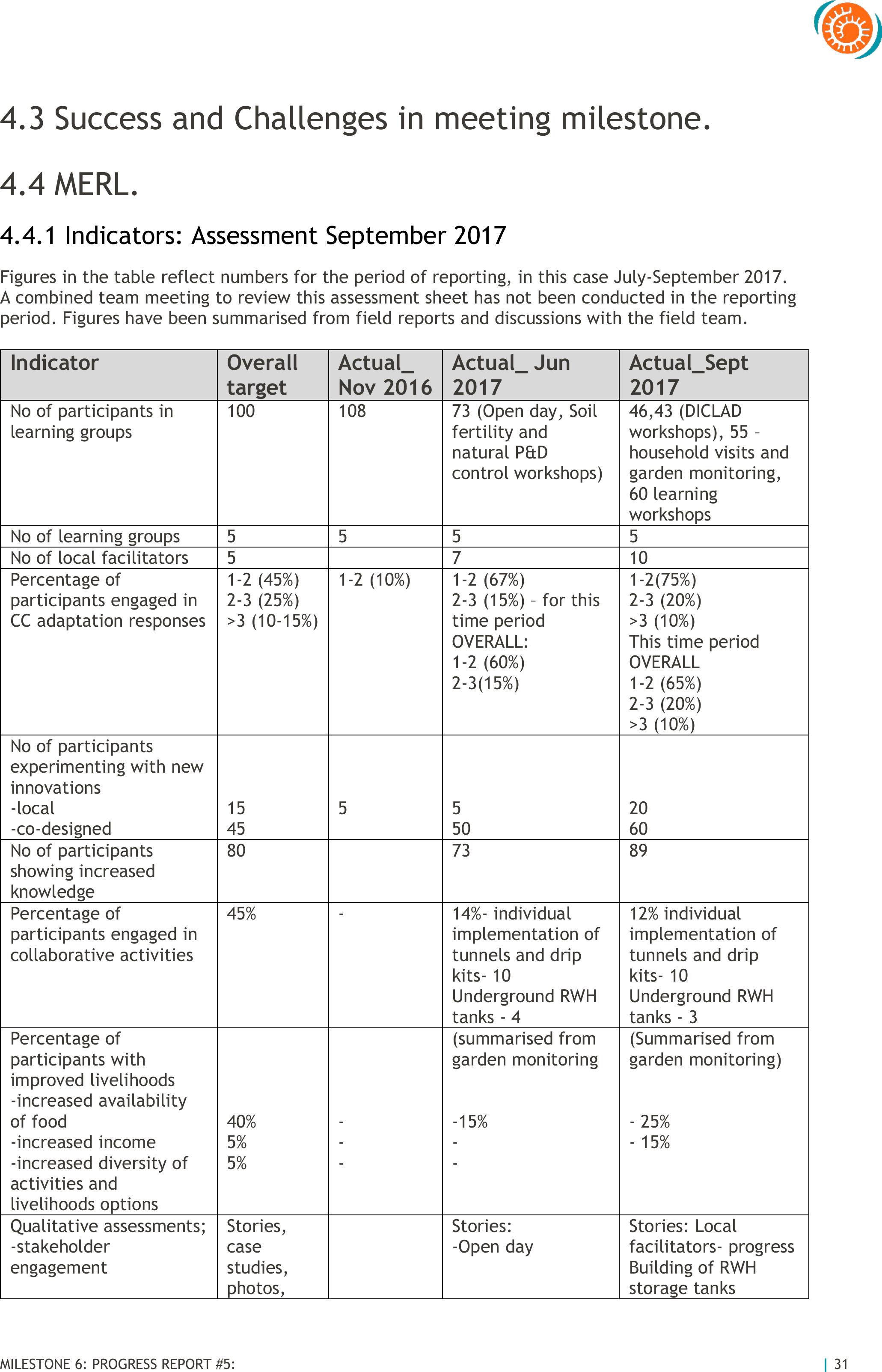
MILESTONE 6: PROGRESS REPORT #5:
| 31
4.3Success and Challenges in meeting milestone.
4.4 MERL.
4.4.1Indicators: Assessment September 2017
Figures in the table reflect numbers for the period of reporting, in this case July-September 2017.
A combined team meeting to review this assessment sheet has not been conducted in the reporting
period. Figures have been summarised from field reports and discussions with the field team.
Indicator
Overall
target
Actual_
Nov 2016
Actual_ Jun
2017
Actual_Sept
2017
No of participants in
learning groups
100
108
73 (Open day, Soil
fertility and
natural P&D
control workshops)
46,43 (DICLAD
workshops), 55 –
household visits and
garden monitoring,
60 learning
workshops
No of learning groups
5
5
5
5
No of local facilitators
5
7
10
Percentage of
participants engaged in
CC adaptation responses
1-2 (45%)
2-3 (25%)
>3 (10-15%)
1-2 (10%)
1-2 (67%)
2-3 (15%) –for this
time period
OVERALL:
1-2 (60%)
2-3(15%)
1-2(75%)
2-3 (20%)
>3 (10%)
This time period
OVERALL
1-2 (65%)
2-3 (20%)
>3 (10%)
No of participants
experimenting with new
innovations
-local
-co-designed
15
45
5
5
50
20
60
No of participants
showing increased
knowledge
80
73
89
Percentage of
participants engaged in
collaborative activities
45%
-
14%- individual
implementation of
tunnels and drip
kits- 10
Underground RWH
tanks - 4
12% individual
implementation of
tunnels and drip
kits- 10
Underground RWH
tanks - 3
Percentage of
participants with
improved livelihoods
-increased availability
of food
-increased income
-increased diversity of
activities and
livelihoods options
40%
5%
5%
-
-
-
(summarised from
garden monitoring
-15%
-
-
(Summarised from
garden monitoring)
-25%
-15%
Qualitative assessments;
-stakeholder
engagement
Stories,
case
studies,
photos,
Stories:
-Open day
Stories: Local
facilitators- progress
Building of RWH
storage tanks
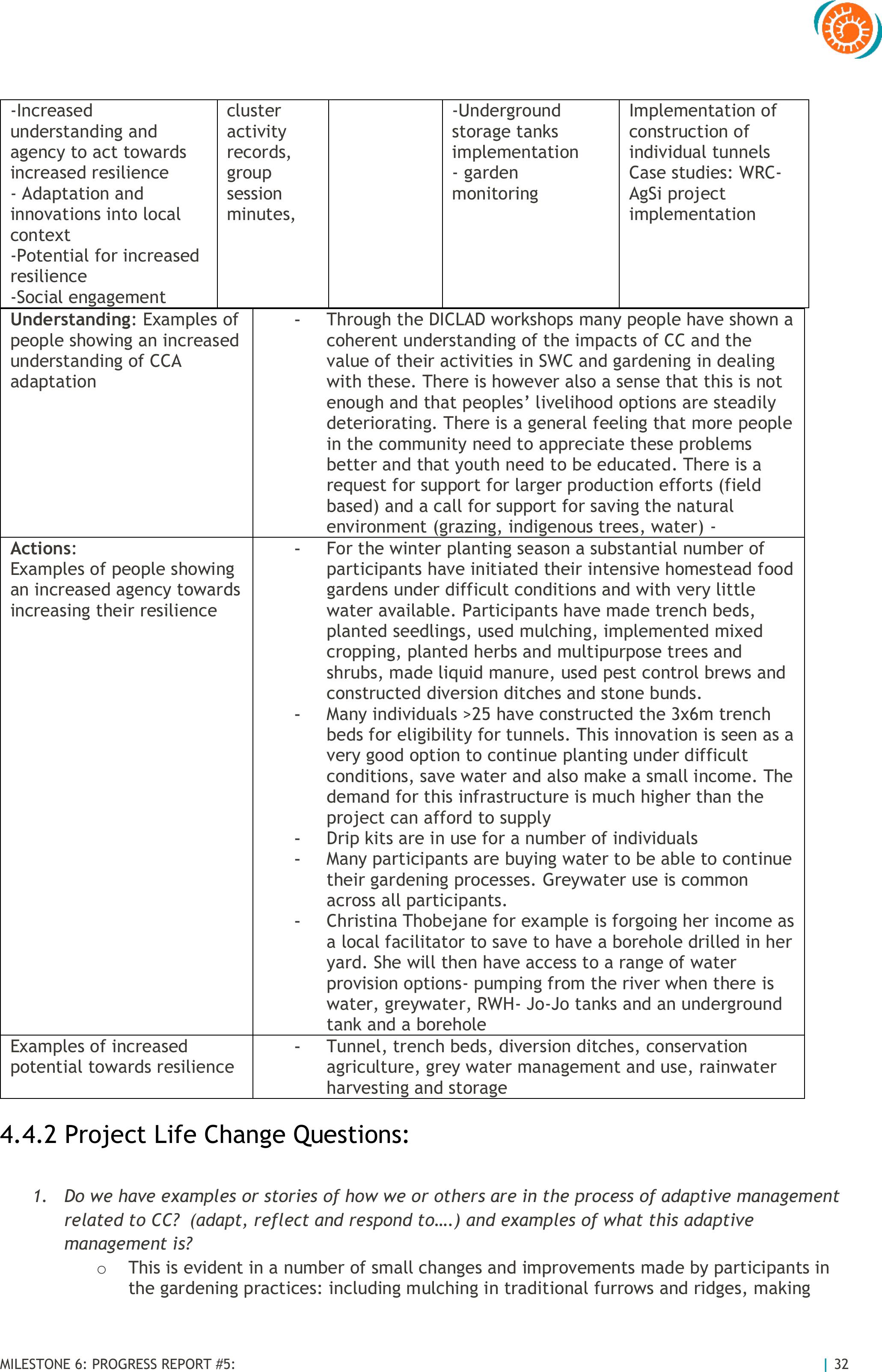
MILESTONE 6: PROGRESS REPORT #5:
| 32
-Increased
understanding and
agency to act towards
increased resilience
- Adaptation and
innovations into local
context
-Potential for increased
resilience
-Social engagement
cluster
activity
records,
group
session
minutes,
-Underground
storage tanks
implementation
- garden
monitoring
Implementation of
construction of
individual tunnels
Case studies: WRC-
AgSi project
implementation
Understanding: Examples of
people showing an increased
understanding of CCA
adaptation
-Through the DICLAD workshops many people have shown a
coherent understanding of the impacts of CC and the
value of their activities in SWC and gardening in dealing
with these. There is however also a sense that this is not
enough and that peoples’ livelihood options are steadily
deteriorating. There is a general feeling that more people
in the community need to appreciate these problems
better and that youth need to be educated. There is a
request for support for larger production efforts (field
based) and a call for support for saving the natural
environment (grazing, indigenous trees, water) -
Actions:
Examples of people showing
an increased agency towards
increasing their resilience
-For the winter planting season a substantial number of
participants have initiated their intensive homestead food
gardens under difficult conditions and with very little
water available. Participants have made trench beds,
planted seedlings, used mulching, implemented mixed
cropping, plantedherbs and multipurpose trees and
shrubs, made liquid manure, used pest control brews and
constructed diversion ditches and stone bunds.
-Many individuals >25 have constructed the 3x6m trench
beds for eligibility for tunnels. This innovation is seen as a
very good option to continue planting under difficult
conditions, save water and also make a small income. The
demand for this infrastructure is much higher than the
project can afford to supply
-Drip kits are in use for a number of individuals
-Many participants are buying water to be able to continue
their gardening processes. Greywater use is common
across all participants.
-Christina Thobejane for example is forgoing her income as
a local facilitator to save to have a borehole drilled in her
yard. She will then have access to a range of water
provision options- pumping from the river when there is
water, greywater, RWH- Jo-Jo tanks and an underground
tank and a borehole
Examples of increased
potential towards resilience
-Tunnel, trench beds, diversion ditches, conservation
agriculture, grey water management and use, rainwater
harvesting and storage
4.4.2Project Life Change Questions:
1. Do we have examples or stories of how we or others are in the process of adaptive management
related to CC? (adapt, reflect and respond to….) and examples of what this adaptive
management is?
oThis is evident in a number of small changes and improvements made by participants in
the gardening practices: including mulching in traditional furrows and ridges, making
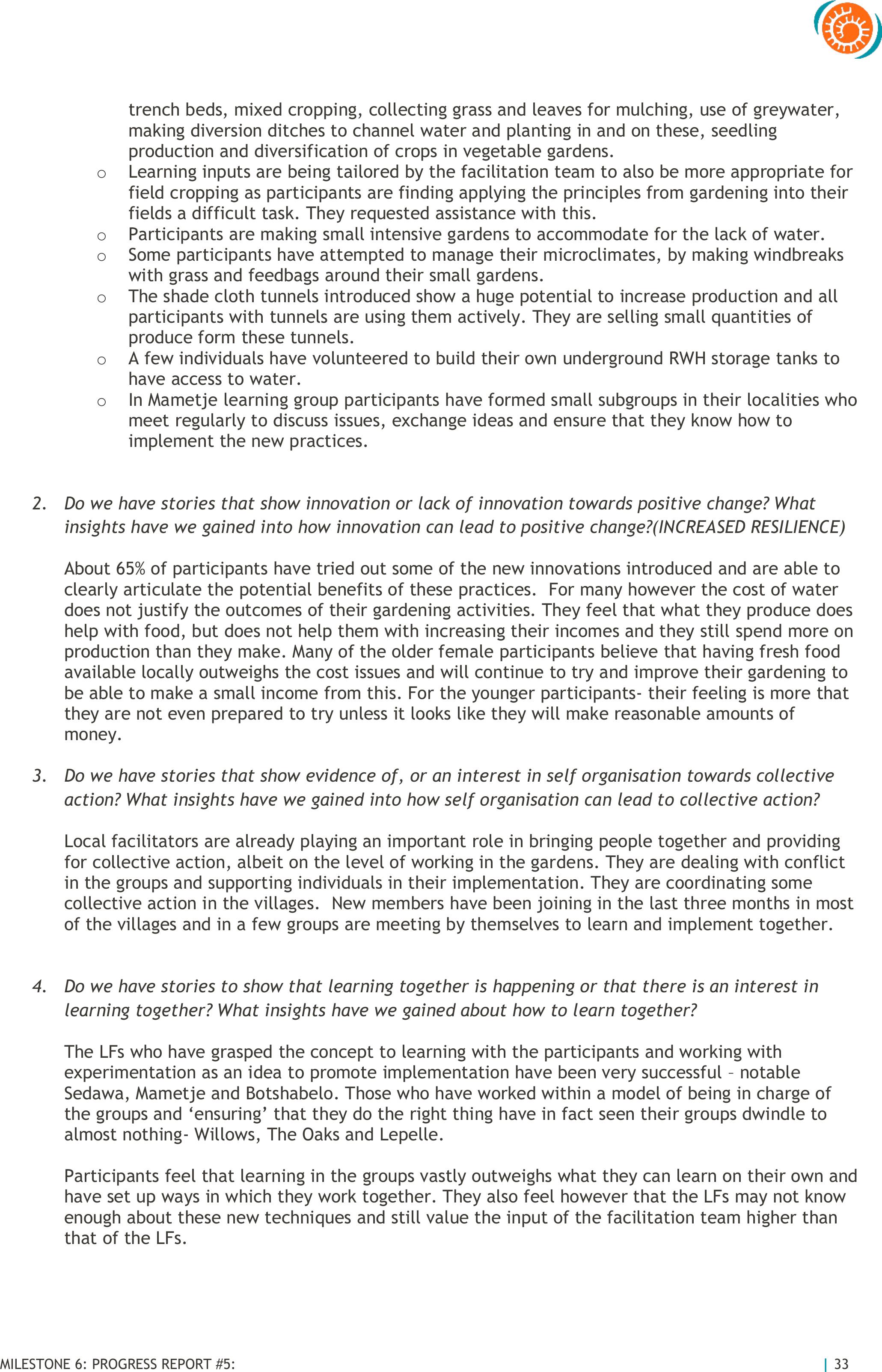
MILESTONE 6: PROGRESS REPORT #5:
| 33
trench beds, mixed cropping, collecting grass and leaves for mulching, use of greywater,
making diversion ditches to channel water and planting in and on these, seedling
production and diversification of crops in vegetable gardens.
oLearning inputs are being tailored by the facilitation team to also be more appropriate for
field cropping as participants are finding applying the principles from gardening into their
fields a difficult task. They requested assistance with this.
oParticipants are making small intensive gardens to accommodate for the lack of water.
oSome participants have attempted to manage their microclimates, by making windbreaks
with grass and feedbags around their small gardens.
oThe shade cloth tunnels introduced show a huge potential to increase production and all
participants with tunnels are using them actively. They are selling small quantities of
produce form these tunnels.
oA few individuals have volunteered to build their own underground RWH storage tanks to
have access to water.
oIn Mametje learning group participants have formed small subgroups in their localities who
meet regularly to discuss issues, exchange ideas and ensure that they know how to
implement the new practices.
2. Do we have stories that show innovation or lack of innovation towards positive change? What
insights have we gained into how innovation can lead to positive change?(INCREASED RESILIENCE)
About 65% of participants have tried out some of the new innovations introduced and are able to
clearly articulate the potential benefits of these practices. For many however the cost of water
does not justify the outcomes of their gardening activities. They feel that what they produce does
help with food, but does not help them with increasing their incomes and they stillspend more on
production than they make. Many of the older female participants believe that having fresh food
available locally outweighs the cost issues and will continue to try and improve their gardening to
be able to make a small income from this. For the younger participants- their feeling is more that
they are not even prepared to try unless it looks like they will make reasonable amounts of
money.
3. Do we have stories that show evidence of, or an interest in self organisation towards collective
action? What insights have we gained into how self organisation can lead to collective action?
Local facilitators are already playing an important role in bringing people together and providing
for collective action, albeit on the level of working in the gardens. They are dealing with conflict
in the groups and supporting individuals in their implementation. They are coordinating some
collective action in the villages. New members have been joining in the last three months in most
of the villages and in a few groups are meeting by themselves to learn and implement together.
4. Do we have stories to show that learning together is happening or that there is an interest in
learning together? What insights have we gained about how to learn together?
The LFs who have grasped the concept to learning with the participants and working with
experimentation as an idea to promote implementation have been very successful –notable
Sedawa, Mametje and Botshabelo. Those who have worked within a model of being in charge of
the groups and ‘ensuring’ that they do the right thing have in fact seen their groups dwindle to
almost nothing- Willows, The Oaks and Lepelle.
Participants feel that learning in the groups vastly outweighs what they can learn on their own and
have set up ways in which they work together. They also feel however that the LFs may not know
enough about these new techniques and still value the input of the facilitation team higher than
that of the LFs.

MILESTONE 6: PROGRESS REPORT #5:
| 34
5. Do we have stories of how we and or others are able to think systemically? What insights have we
gained?
The DICLAD workshops have pointed to a remarkable capacity in the community members to make
the linkages and realise the larger impacts of actions. It is however hard for them to translate this
into ideas about how collective action can change the systemic interactions- or more precisely
they do not feel that they can work together on these issues without assistance from the outside.
6. Do we have stories of how we and or others are able to be inclusive and democratic? What
insights have we gained about how this can be achieved? (STAKEHOLDER ENGAGEMENT).
Some advances have been made in stakeholder interaction in working with other NGOs active in
the area towards working together and limited sharing of implementation budgets. Cementing the
process around climate change and adaptation has assisted stakeholders to more clearly
understand the needs for this cooperation. Lima RDF has agreed to share the learning and training
processes and to augment the process where they have specific strengths. They have agreed to be
party to the CC adaptation approach and to frame their interventions and discussions in this way
and also to support beneficiaries with small grants for provision of more tunnels and drip kits.
4.4.3Work Plan for the coming three months.
The last three months of this intervention will focus on the following activities:
1. Continuation of the 2nd workshop in the DICLAD process, combined with a review of activities
and impacts of implementation in the learning groups to date.
2. Negotiation for continuation of the process through AWARD for the coming year
3. Negotiation of a partnership with the WRC project on community level adaptation to ensure
continuation and co-funding of the process going forward (2-3 years) –albeit on a much reduced
level of implementation
4. Collaboration with Lima RDFin combining activities across the two programmes- their food
security and small business initiative and AgSI. Training of facilitators in climate sensitive
facilitation and implementation of best bet options for good practices will be undertaken.
5. Continuation of garden monitoring and support for Local Facilitators
6. Finalisation of learning workshops around review of gardening techniques and conservation
agriculture.
7. Limited support for afocus on fruit tree production, notably in Lepelle and Willows where
participants have requested trees.
8. Monitoring processes are to be put in place for management of the tunnels constructed and also
the 3 underground RWH tanks.
9. Village level cross visits for all participants to explore and interrogate the options for tunnels
and RWH storage, as well as other innovations introduced.
10. Compilation and analysis of garden monitoring information.
11. Writing of a final report for this process.
The next field visit for the Mahlathini team will be from 16-27 October 2017.

MILESTONE 6: PROGRESS REPORT #5:
| 35
4.5Communication Materials from this milestone.
The production of communication materials is still being negotiated with the Agricultural Coordinator and
the communications team. Themid term community level review has been posted on the Mahlathini
website. www.mahlathini.org
4.6Other outputs
A case study has been written (See Appendix 1) jointly between Mahlathini and the relevant AWARD staff
for a Water Research Commission (WRC) brief entitled: Collaborative knowledge creation and mediation
strategies for the dissemination of Water and Soil Conservation practices and Climate Smart
Agriculture in smallholder farming systems. Deliverable No.2:Report on stakeholder engagement,
case study development and site identification(August 2017)
The MDF has participated in the planning and implementation of the DICLAD process in the Mametje area.
The overall purpose of these workshops was to build climate change literacy among stakeholders with
regards to climate projections and impacts related to small scale agriculture. These workshops
particularly involved small scale farmers who are participating in the learning groups being established
and guided by the sub grant Mahlathini in the Mametja area (Lower Olifants).
The expected outcomes were the following.
•An understanding of some core concepts related to climate change and localised climate projections.
•An understanding of general climatechange impacts pertaining tosmallscale farming practices in the
Middle Olifants.
Three workshops were included:
•17 August 2017 with Sedawa and Willows (48 participants);
•21 August 2017 with Botshabelo (13 participants); and
•27 September 2017 as a combined workshop with Lepelle, Oaks and Finale.
A draft report has been compiled for the DICLAD workshop undertaken in Sedawa(Appendix 2: DICLAD_
Conversations about farming and climate change_ Principles for good farming practices –Sedawa
20170817)
5Overall Progress of Project
5.1Integration of milestone status.
The table below indicates overall completion of activities according to milestones. Activities are all well on
track for completion in December 2017
Table 5: Milestone target completion July-September 2017.
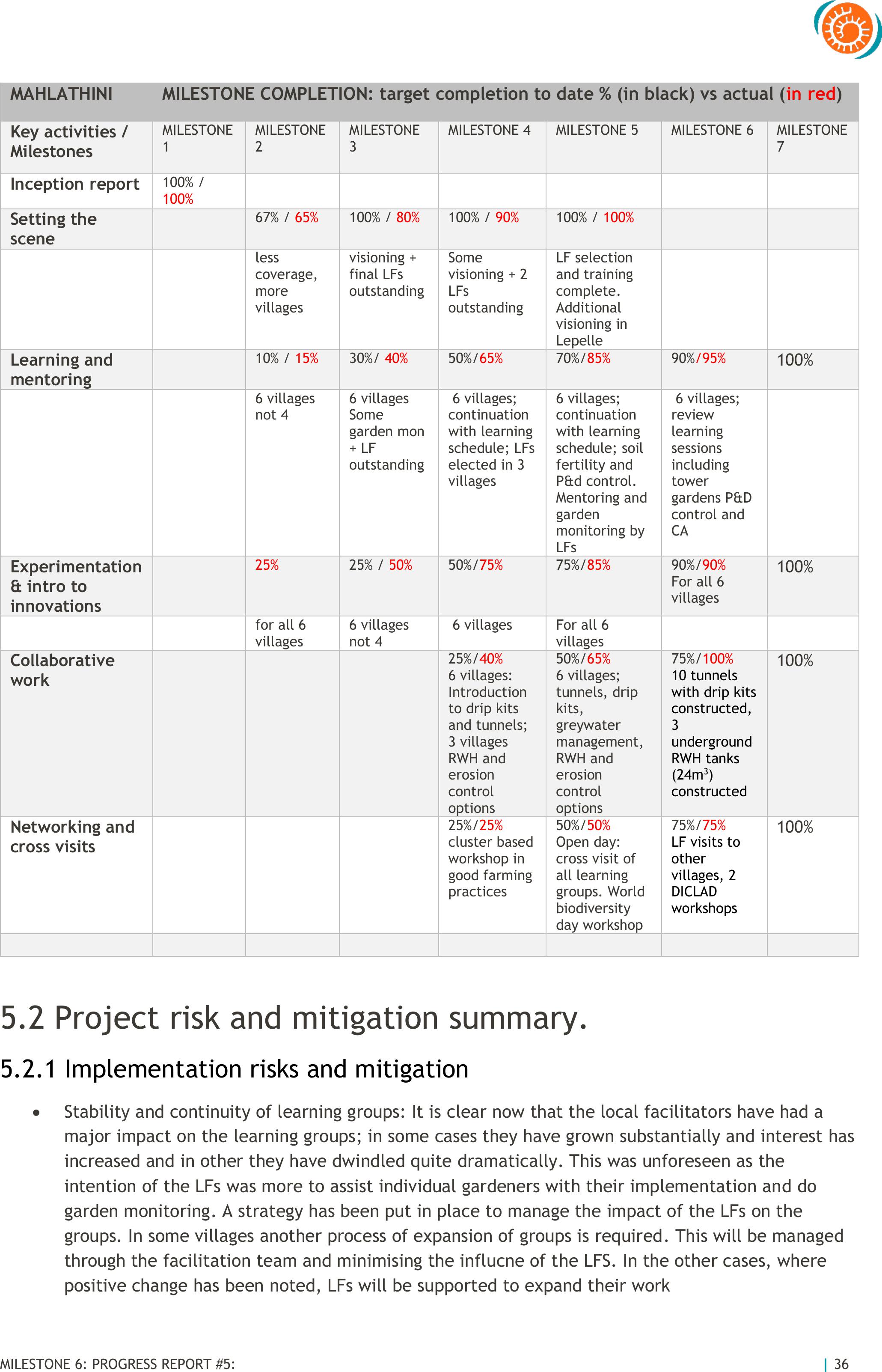
MILESTONE 6: PROGRESS REPORT #5:
| 36
5.2Project risk and mitigation summary.
5.2.1Implementation risks and mitigation
•Stability and continuity of learning groups: It is clear now that the local facilitators have had a
major impact on the learning groups; in some cases they have grown substantially and interest has
increased and in other they have dwindled quite dramatically. This was unforeseen as the
intention of the LFs was more to assist individual gardeners with their implementation and do
garden monitoring. A strategy has been put in place to manage the impact of the LFs on the
groups. In some villages another process of expansion of groups is required. This will be managed
through the facilitation team and minimising the influcne of the LFS. In the other cases, where
positive change has been noted, LFs will be supported to expand their work
MAHLATHINI
MILESTONE COMPLETION: target completion to date % (in black) vs actual (in red)
Key activities /
Milestones
MILESTONE
1
MILESTONE
2
MILESTONE
3
MILESTONE 4
MILESTONE 5
MILESTONE 6
MILESTONE
7
Inception report
100% /
100%
Setting the
scene
67% / 65%
100% / 80%
100% / 90%
100% / 100%
less
coverage,
more
villages
visioning +
final LFs
outstanding
Some
visioning + 2
LFs
outstanding
LF selection
and training
complete.
Additional
visioning in
Lepelle
Learning and
mentoring
10% / 15%
30%/ 40%
50%/65%
70%/85%
90%/95%
100%
6 villages
not 4
6 villages
Some
garden mon
+ LF
outstanding
6 villages;
continuation
with learning
schedule; LFs
elected in 3
villages
6 villages;
continuation
with learning
schedule; soil
fertility and
P&d control.
Mentoring and
garden
monitoring by
LFs
6 villages;
review
learning
sessions
including
tower
gardens P&D
control and
CA
Experimentation
& intro to
innovations
25%
25% / 50%
50%/75%
75%/85%
90%/90%
For all 6
villages
100%
for all 6
villages
6 villages
not 4
6 villages
For all 6
villages
Collaborative
work
25%/40%
6 villages:
Introduction
to drip kits
and tunnels;
3 villages
RWH and
erosion
control
options
50%/65%
6 villages;
tunnels, drip
kits,
greywater
management,
RWH and
erosion
control
options
75%/100%
10 tunnels
with drip kits
constructed,
3
underground
RWH tanks
(24m3)
constructed
100%
Networking and
cross visits
25%/25%
cluster based
workshop in
good farming
practices
50%/50%
Open day:
cross visit of
all learning
groups. World
biodiversity
day workshop
75%/75%
LF visits to
other
villages, 2
DICLAD
workshops
100%
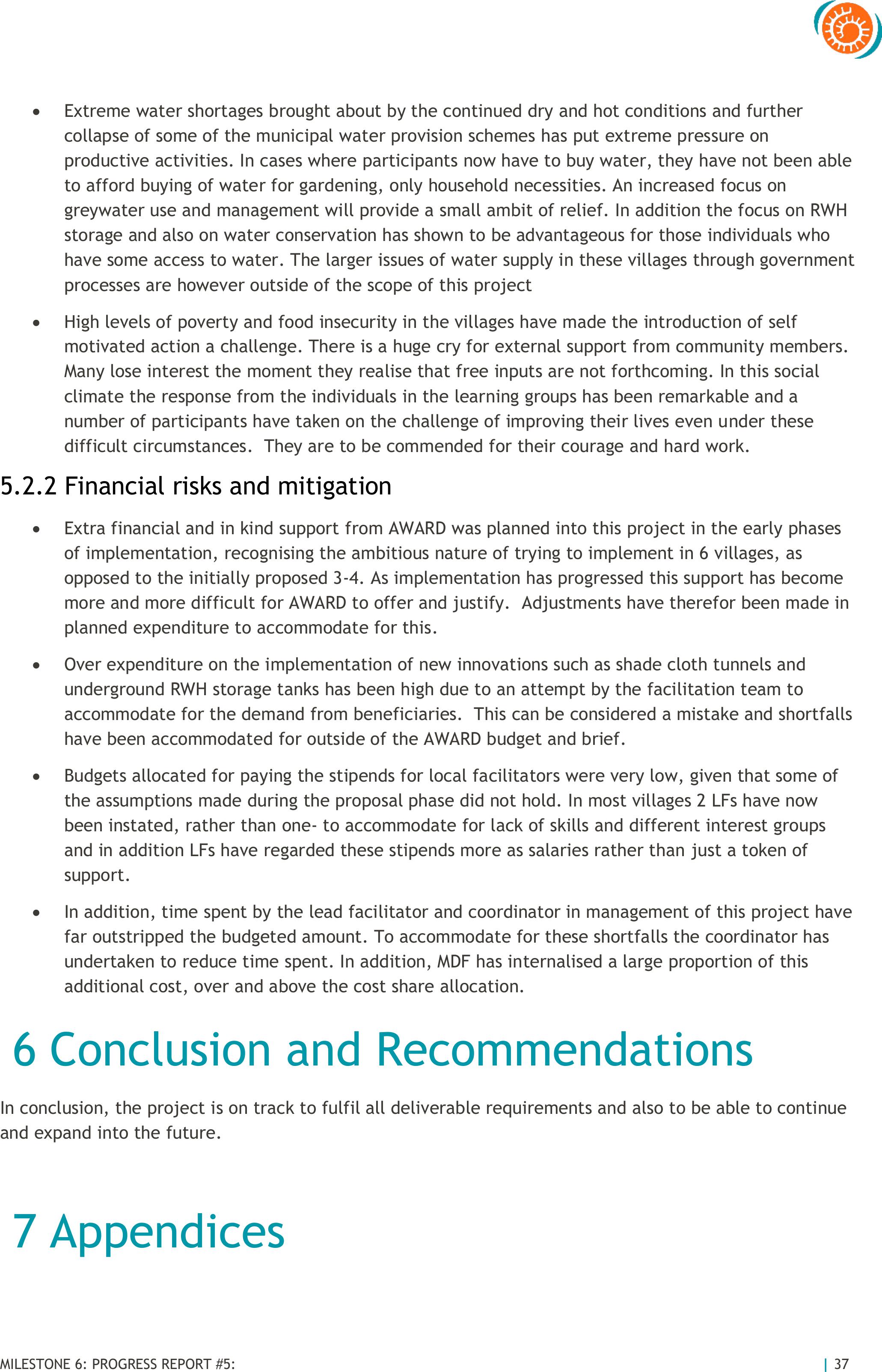
MILESTONE 6: PROGRESS REPORT #5:
| 37
•Extreme water shortages brought about by the continued dry and hot conditions and further
collapse of some of the municipal water provision schemeshas put extreme pressure on
productive activities. In cases where participants now have to buy water, they have not been able
to afford buying of water for gardening, only household necessities. An increased focus on
greywater use and management will provide a small ambit of relief. In addition the focus on RWH
storage and also on water conservation has shown to be advantageous for those individuals who
have some access to water. The larger issues of water supply in these villages through government
processes are however outside of the scope of this project
•High levels of poverty and food insecurity in the villages have made the introduction of self
motivated action a challenge. There is a huge cry for external support from community members.
Many lose interest the moment they realise that free inputs are not forthcoming. In this social
climate the response from the individuals in the learning groups has been remarkable and a
number of participants have taken on the challenge of improving their lives even under these
difficult circumstances. They are to be commended for their courage and hard work.
5.2.2Financial risks and mitigation
•Extra financial and in kind support from AWARD was planned into this project in the early phases
of implementation, recognising the ambitious nature of trying to implement in 6 villages, as
opposed to the initially proposed 3-4. As implementation has progressed this support has become
more and more difficult for AWARD to offer and justify.Adjustments have therefor been made in
planned expenditure to accommodate for this.
•Over expenditure on the implementation of new innovations such as shade cloth tunnels and
underground RWH storage tanks has been high due to an attempt by the facilitation team to
accommodate for the demand from beneficiaries. This can be considered a mistake and shortfalls
have been accommodated for outside of the AWARD budget and brief.
•Budgets allocated for paying the stipends for local facilitators were very low, given that some of
the assumptions made during the proposal phase did not hold. In most villages 2 LFs have now
been instated, rather than one- to accommodate for lack of skills and different interest groups
and in addition LFs have regarded these stipends more as salaries rather than just a token of
support.
•In addition, time spent by the lead facilitator and coordinator in management of this project have
far outstripped the budgeted amount. To accommodate for these shortfalls the coordinator has
undertaken to reduce time spent. In addition, MDF has internalised a large proportion of this
additional cost, over and above the cost share allocation.
6Conclusion and Recommendations
In conclusion, the project is on track to fulfil all deliverable requirements and also to be able to continue
and expand into the future.
7 Appendices
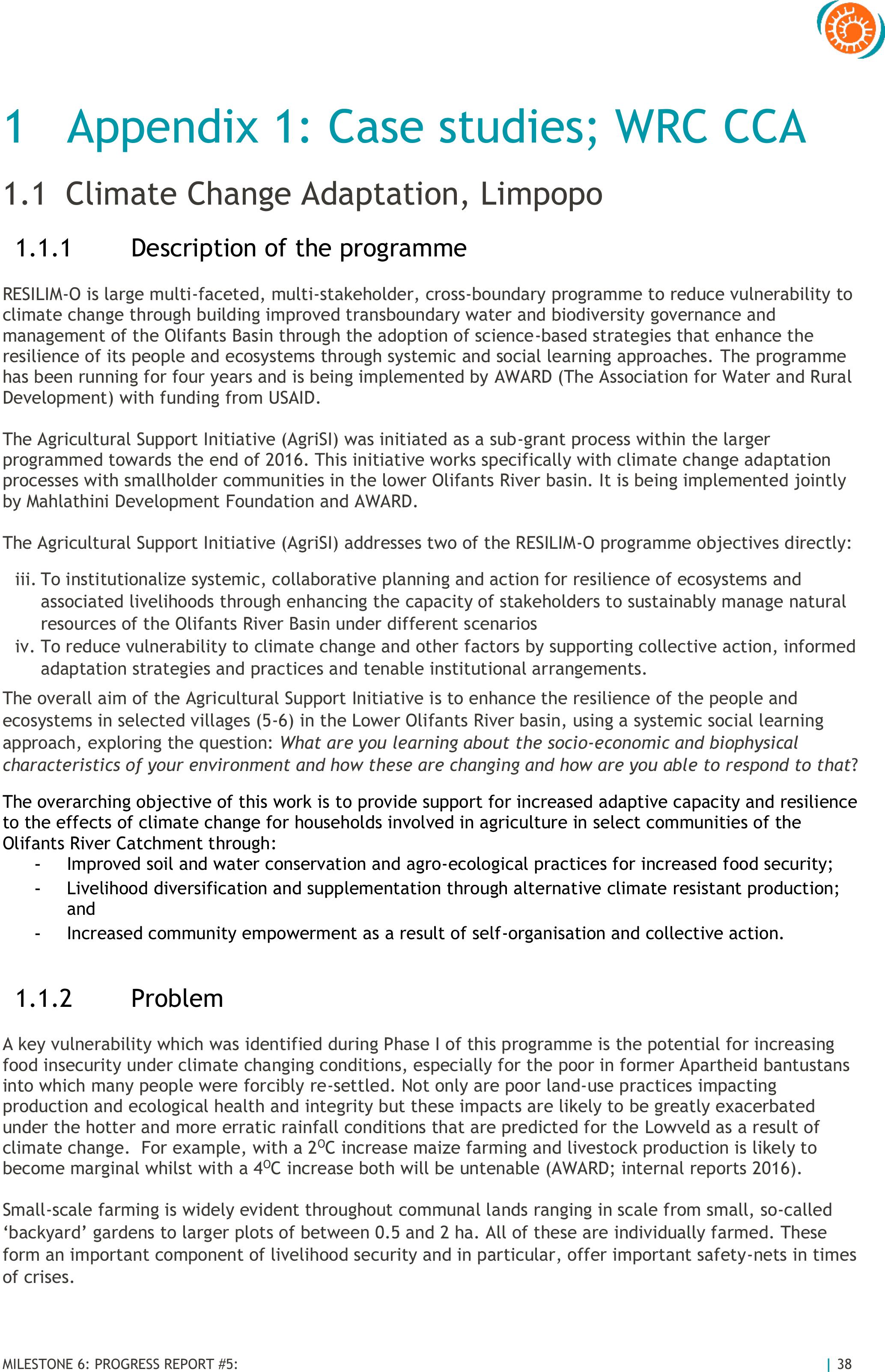
MILESTONE 6: PROGRESS REPORT #5:
| 38
1Appendix 1: Case studies; WRC CCA
1.1Climate Change Adaptation, Limpopo
1.1.1Description of the programme
RESILIM-O is large multi-faceted, multi-stakeholder, cross-boundary programme to reduce vulnerability to
climate change through building improved transboundary water and biodiversity governance and
management of the Olifants Basin through the adoption of science-based strategies that enhance the
resilience of its people and ecosystems through systemic and social learning approaches.The programme
has been running for four years and is being implemented byAWARD (The Association for Water and Rural
Development) with funding from USAID.
The Agricultural Support Initiative (AgriSI) was initiated as a sub-grant process within the larger
programmed towards the end of 2016. This initiative works specifically with climate change adaptation
processes with smallholder communities in the lower Olifants River basin. It is being implemented jointly
by Mahlathini Development Foundation and AWARD.
The Agricultural Support Initiative (AgriSI) addresses two of the RESILIM-O programme objectives directly:
iii. To institutionalize systemic, collaborative planning and action for resilience of ecosystems and
associated livelihoods through enhancing the capacity of stakeholders to sustainably manage natural
resources of the Olifants River Basin under different scenarios
iv. To reduce vulnerability to climate change and other factors by supporting collective action, informed
adaptation strategies and practices and tenable institutional arrangements.
The overall aim of the Agricultural Support Initiative is to enhance the resilience of the people and
ecosystems in selected villages (5-6) in the Lower Olifants River basin, using a systemic social learning
approach, exploring the question:What are you learning about the socio-economic and biophysical
characteristics of your environment and how these are changing and how are you able to respond to that?
The overarching objective of this work is to provide support for increased adaptive capacity and resilience
to the effects of climate change for households involved in agriculture in select communities of the
Olifants River Catchment through:
-Improved soil and water conservation and agro-ecological practices for increased food security;
-Livelihood diversification and supplementation through alternative climate resistant production;
and
-Increased community empowerment as a result of self-organisation and collective action.
1.1.2 Problem
A key vulnerabilitywhich was identified during Phase I of this programme is the potential for increasing
food insecurity under climate changing conditions, especially for the poor in former Apartheid bantustans
into which many people were forcibly re-settled. Not only are poor land-use practices impacting
production and ecological health and integrity but these impacts are likely to be greatly exacerbated
under the hotter and more erratic rainfall conditions that are predicted for the Lowveld as a result of
climate change. For example, with a 2OC increase maize farming and livestock production is likely to
become marginal whilst with a 4OC increase both will be untenable (AWARD; internal reports 2016).
Small-scale farming is widely evident throughout communal lands ranging in scale from small, so-called
‘backyard’ gardens to larger plots of between 0.5 and 2 ha. All of these are individually farmed. These
form an important component of livelihood security and in particular, offer important safety-nets in times
of crises.

MILESTONE 6: PROGRESS REPORT #5:
| 39
However, not only are current poor farming practices exposing farmers to unnecessary risks through loss of
ecological health but these are likely to be highly exacerbated with climate change. Current practices
typically do little to manage water movement and retention, soil health and loss and offer little resilience
in terms of crop choices, for example. From a social and institutional perspective there is little evidence
of farmers working together to learn from each other or others or to plan for the future. Collective action
and the ability to self-organise are regarded as critical components of adaptive capacity. Furthermore,
although some farmers have indicated that they haveheard of climate change, none expressed a sense of
urgency and few voiced any ideas about how to respond. Thissuggests that collectively they are not
resilient in a way that the magnitude of the impacts of climate change might demand. Building adaptive
capacity for food security is thus a key priority of the project.
1.1.3 Rationale
Sound agro-ecological practices for soil and water conservation (SWC) and the ability to self-organise and
act collectively are regarded as fundamental for building adaptive capacity and resilience. Not only do
agro-ecological farming approaches require minimum external inputs –which may be expensive and
increase dependency if subsidised – but they foster farmers’ sense that they can build sustainable futures
from local inputs and efforts. With knowledge about the potential impacts of climate change included in
the learning journey, farmers can make purposeful decisions around practices such as seed and crop-type.
This approach supports livelihood diversification –also fundamental for increased resilience –through
‘value-added’ associated activities such as seedling production, tree nurseries and bee-keeping.
The overarching objective of this work is to provide support for increased adaptive capacity and resilience
to the effects of climate change for households involved in agriculture in select communities of the
Olifants River Catchment through:
-Improved soil and water conservation and agro-ecological practices for increased food security
-Livelihood diversification and supplementation through alternative climate resistant production;
-Increased community empowerment as a result of self-organisation and collective action.
1.1.4Implementation of practices
Six villages were given priority due to their medium to high vulnerability status with respect to food
security under climate changing conditions and the existence of already active and interested
smallholders. These villages, shown in Error! Reference source not found., are Botshabelo (Mabins A);
Mametja (Mabins B); Lepelle; Willows, The Oaks and Finale.
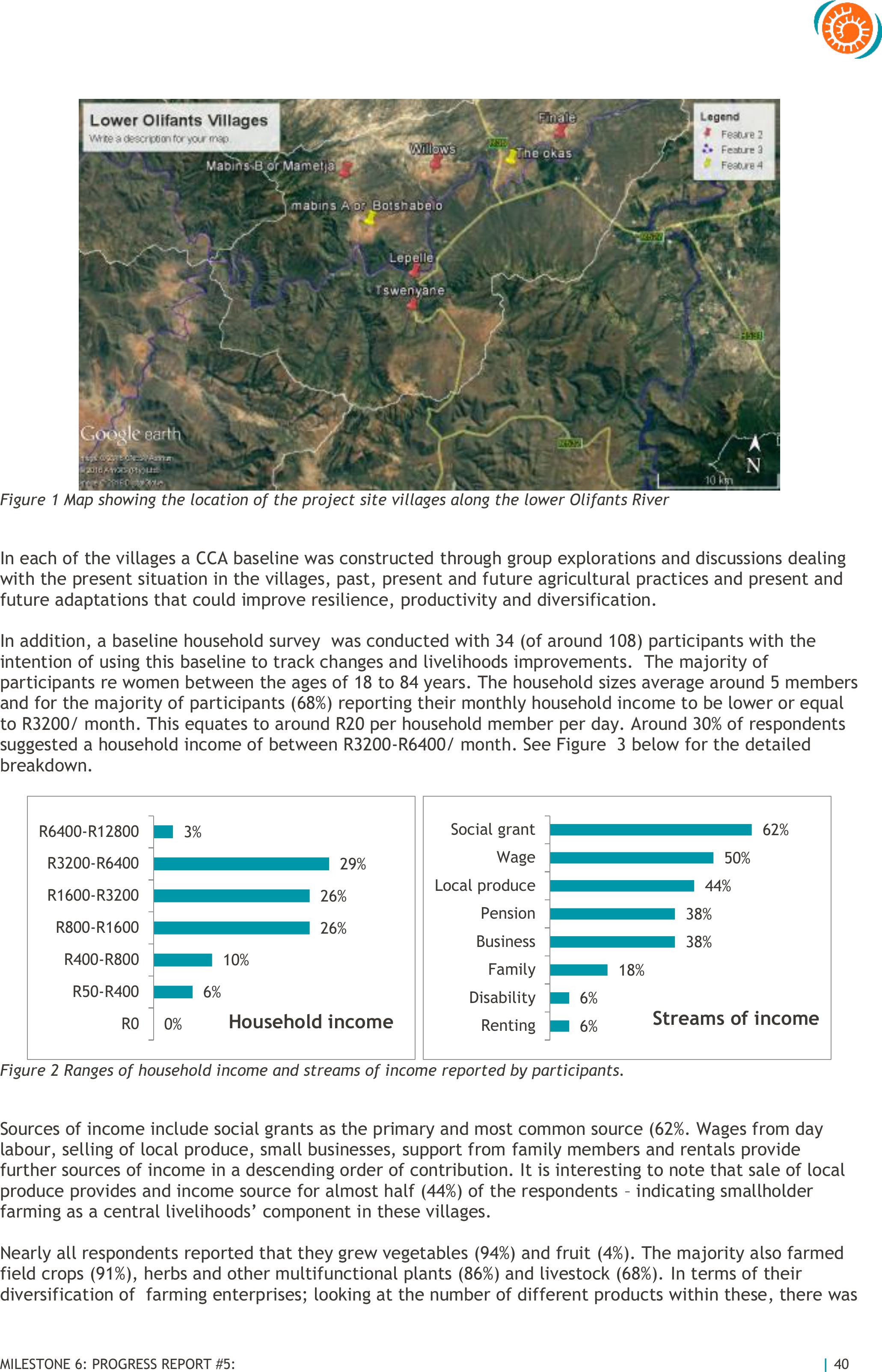
MILESTONE 6: PROGRESS REPORT #5:
| 40
Figure 1 Map showing the location of the project site villages along the lower Olifants River
In each of the villages a CCA baseline was constructedthrough group explorations and discussionsdealing
with the present situation in the villages, past, present and future agricultural practices and present and
future adaptations that could improve resilience, productivity and diversification.
In addition, a baseline household survey was conducted with 34 (of around 108) participants with the
intention of using this baseline to track changes and livelihoods improvements. The majority of
participants re women between the ages of 18 to 84 years. The household sizes average around 5 members
and for the majority of participants (68%) reporting their monthly household income to be lower or equal
to R3200/ month. This equates to around R20 per household member per day. Around 30% of respondents
suggested a household income of between R3200-R6400/ month. See Figure 3 below for the detailed
breakdown.
Figure 2 Ranges of household income and streams of income reported by participants.
Sources of income include social grants as the primary and most common source (62%. Wages from day
labour, selling of local produce, small businesses, support from family members and rentals provide
further sources of income in a descending order of contribution. It is interesting to note that sale of local
produce provides and income source for almost half (44%) of the respondents –indicating smallholder
farming as a central livelihoods’ component in these villages.
Nearly all respondents reported that they grew vegetables (94%) and fruit (4%). The majority also farmed
field crops (91%), herbs and other multifunctional plants (86%) and livestock (68%).In terms of their
diversification of farming enterprises; looking at the number of different products within these, there was
0%
6%
10%
26%
26%
29%
3%
R0
R50-R400
R400-R800
R800-R1600
R1600-R3200
R3200-R6400
R6400-R12800
Household income
6%
6%
18%
38%
38%
44%
50%
62%
Renting
Disability
Family
Business
Pension
Local produce
Wage
Social grant
Streams of income
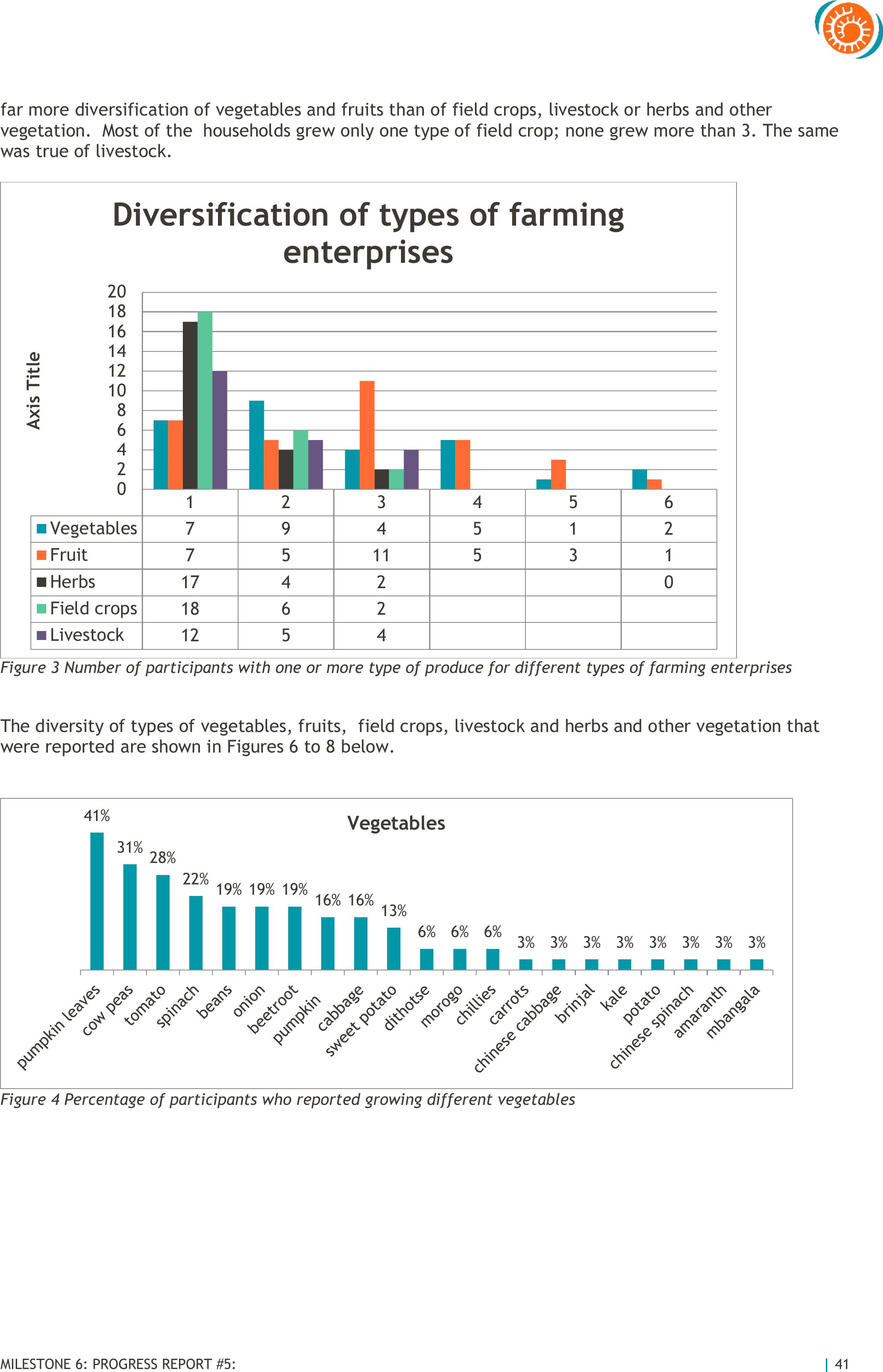
MILESTONE 6: PROGRESS REPORT #5:
| 41
far more diversification of vegetables and fruits than of field crops, livestock or herbs and other
vegetation. Most of the households grew only one type of field crop; none grew more than 3. The same
was true of livestock.
Figure 3 Number of participants with one or more type of produce for different types of farming enterprises
The diversity of types of vegetables, fruits, field crops, livestock and herbs and other vegetation that
were reported are shown in Figures 6 to 8 below.
Figure 4 Percentage of participants who reported growing different vegetables
1 2 3 4 5 6
Vegetables 7 9 4 5 1 2
Fruit 75 11 5 3 1
Herbs 17 4 20
Field crops18 6 2
Livestock 12 5 4
0
2
4
6
8
10
12
14
16
18
20
Axis Title
Diversification of types of farming
enterprises
41%
31% 28%
22% 19% 19% 19% 16% 16% 13%
6% 6% 6% 3% 3% 3% 3% 3% 3% 3% 3%
Vegetables
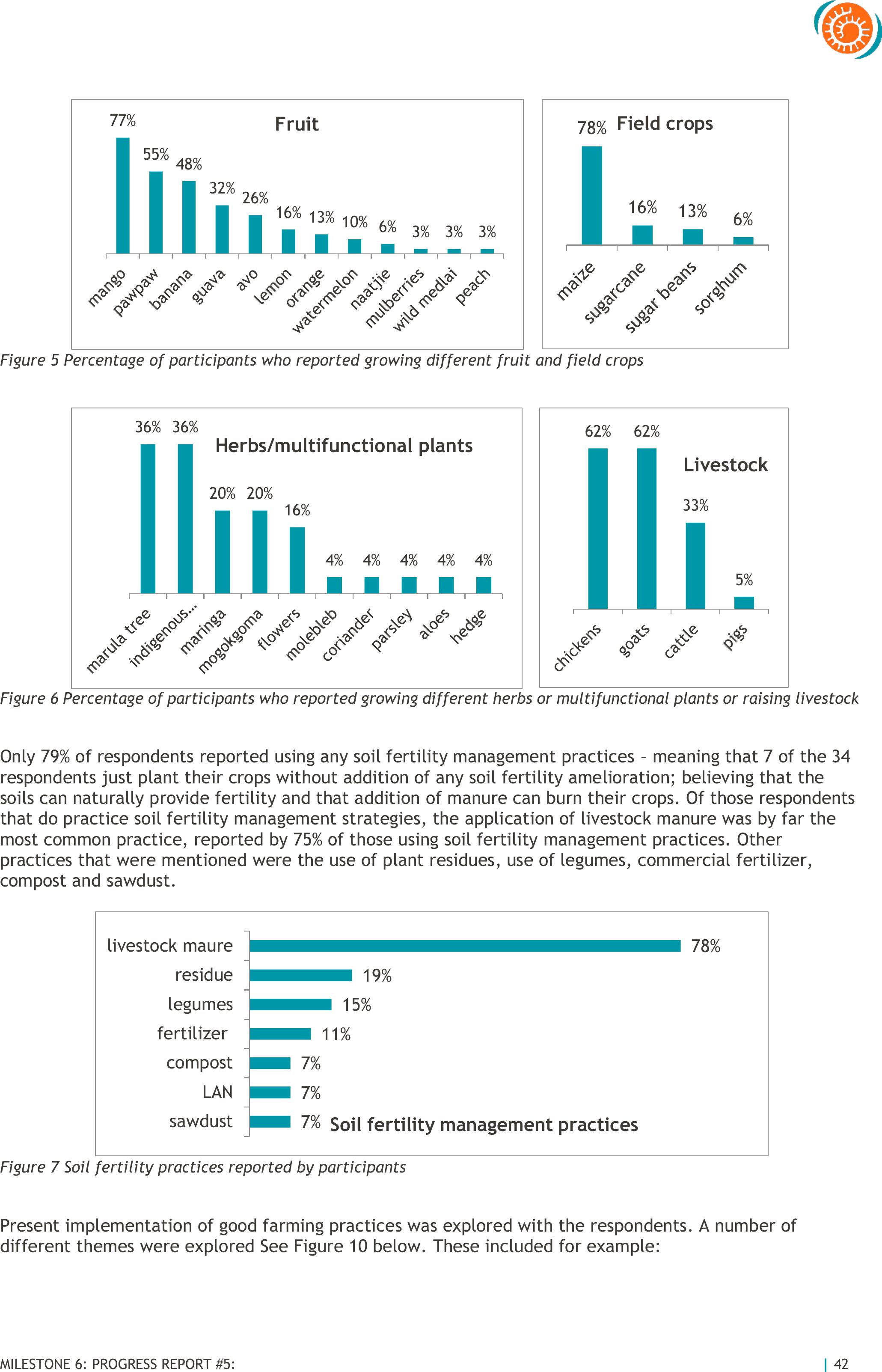
MILESTONE 6: PROGRESS REPORT #5:
| 42
Figure 5 Percentage of participants who reported growing different fruit and field crops
Figure 6Percentage of participants who reported growing different herbs or multifunctional plants or raising livestock
Only 79% of respondents reported using any soil fertility management practices –meaning that 7 of the 34
respondents just plant their crops without addition of any soil fertility amelioration; believing that the
soils can naturally provide fertility and that addition of manure can burn their crops. Of those respondents
that do practice soil fertility management strategies, theapplication of livestock manure was by far the
most common practice, reported by 75% of those using soil fertility management practices. Other
practices that were mentioned were the use of plant residues, use of legumes, commercial fertilizer,
compost and sawdust.
Figure 7 Soil fertility practices reported by participants
Present implementation of good farming practices was explored with the respondents. A number of
different themes were explored See Figure 10 below. These included for example:
77%
55% 48%
32% 26% 16% 13% 10% 6% 3% 3% 3%
Fruit
78%
16% 13% 6%
Field crops
36% 36%
20% 20%
16%
4% 4% 4% 4% 4%
Herbs/multifunctional plants
62% 62%
33%
5%
Livestock
7%
7%
7%
11%
15%
19%
78%
sawdust
LAN
compost
fertilizer
legumes
residue
livestock maure
Soil fertility management practices
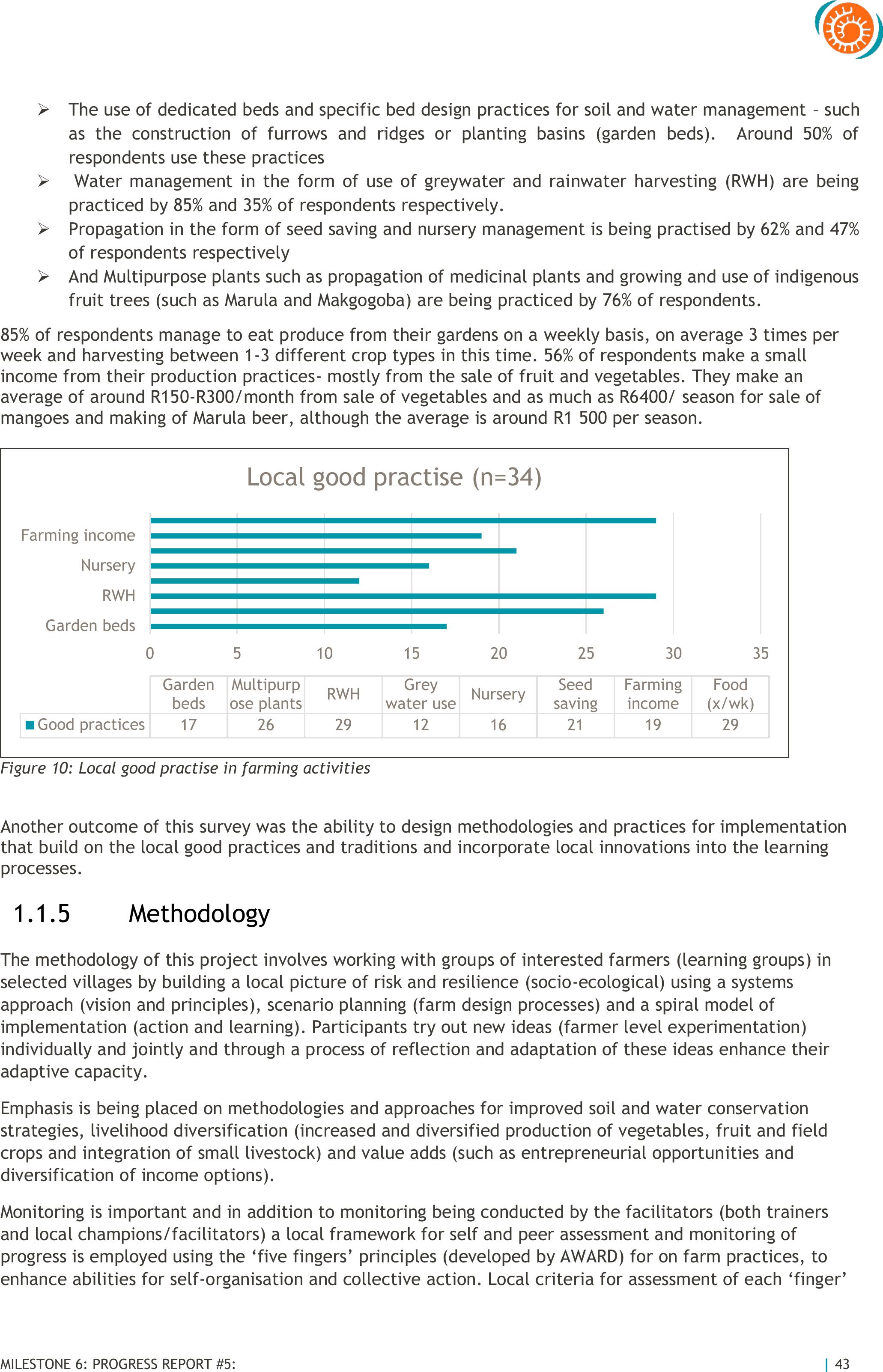
MILESTONE 6: PROGRESS REPORT #5:
| 43
➢The use of dedicated beds and specific bed design practices for soil and water management –such
as the construction of furrows and ridges or planting basins (garden beds). Around 50% of
respondents use these practices
➢Water management in the form of use of greywater and rainwater harvesting (RWH) are being
practiced by 85% and 35% of respondents respectively.
➢Propagation in the form of seed saving and nursery management is being practised by 62% and 47%
of respondents respectively
➢And Multipurpose plants such as propagation of medicinal plants and growing and use of indigenous
fruit trees (such as Marula and Makgogoba) are being practiced by 76% of respondents.
85% of respondents manage to eat produce from their gardens on a weekly basis, on average 3 times per
week and harvesting between 1-3 different crop types in this time. 56% of respondents make a small
income from their production practices- mostly from the sale of fruit and vegetables. They make an
average of around R150-R300/month from sale of vegetables and as much as R6400/ season for sale of
mangoes and making of Marula beer, although the average is around R1500 per season.
Figure 10: Local good practise in farming activities
Another outcome of this survey was the ability to design methodologies and practices for implementation
that build on the local good practices and traditions and incorporate local innovations into the learning
processes.
1.1.5 Methodology
The methodology of this project involves working with groups of interested farmers (learning groups) in
selected villages by building a local picture of risk and resilience (socio-ecological) using a systems
approach (vision and principles), scenario planning (farm design processes) and a spiral model of
implementation (action and learning). Participants try out new ideas (farmer level experimentation)
individually and jointly and through a process of reflection and adaptation of these ideas enhance their
adaptive capacity.
Emphasis is being placed on methodologies and approaches for improved soil and water conservation
strategies, livelihood diversification (increased and diversified production of vegetables, fruit and field
crops and integration of small livestock) and value adds (such as entrepreneurial opportunities and
diversification of income options).
Monitoring is important and in addition to monitoring being conducted by the facilitators (both trainers
and local champions/facilitators) a local framework for self and peer assessment and monitoring of
progress is employed using the ‘five fingers’ principles (developed by AWARD) for on farm practices, to
enhance abilities for self-organisation and collective action. Local criteria for assessment of each ‘finger’
05 10 15 20 25 30 35
Garden beds
RWH
Nursery
Farming income
Garden
beds
Multipurp
ose plantsRWH Grey
water useNursery Seed
saving
Farming
income
Food
(x/wk)
Good practices17 26 29 12 16 21 19 29
Local good practise (n=34)
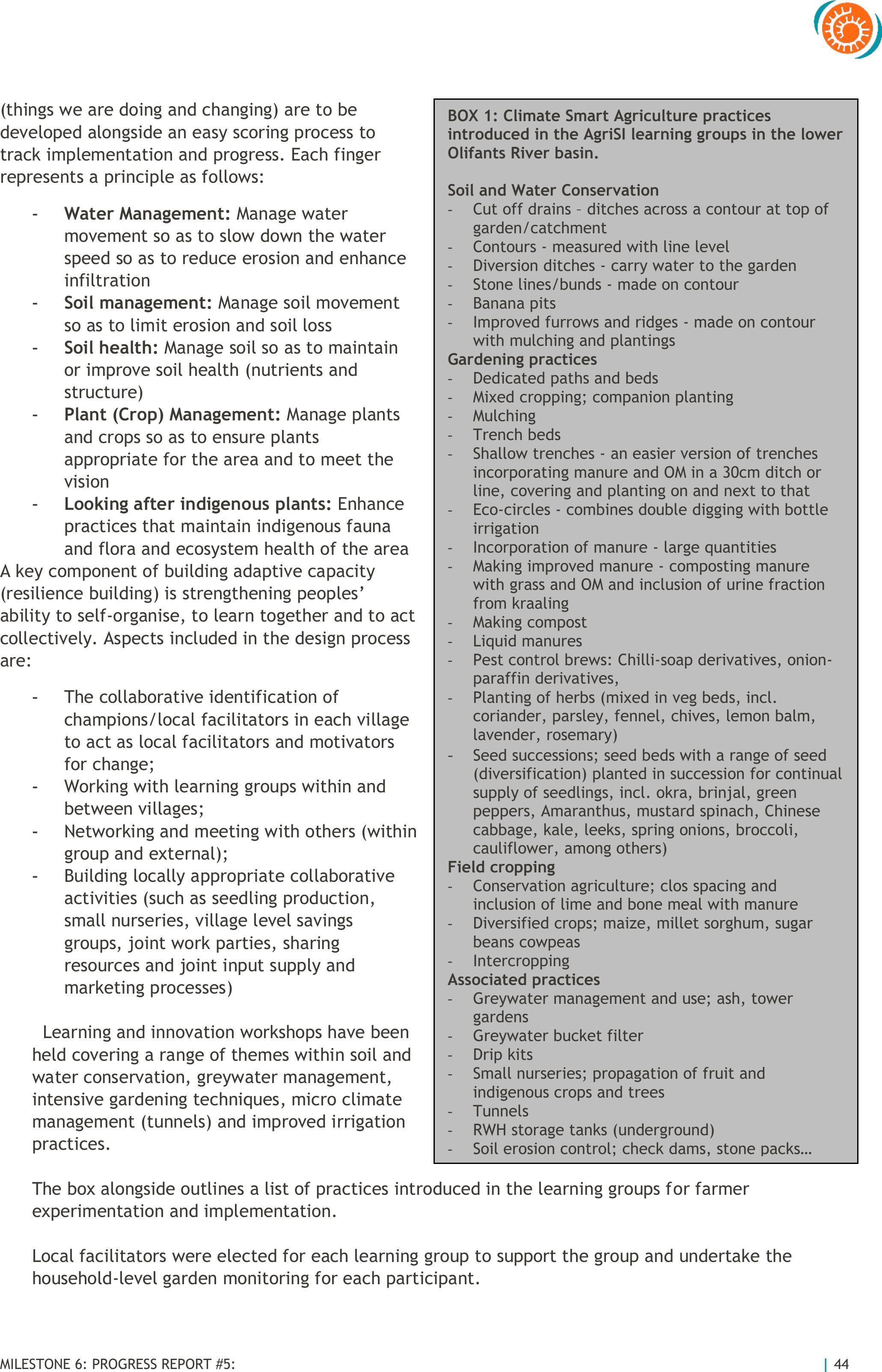
MILESTONE 6: PROGRESS REPORT #5:
| 44
(things we are doing and changing) are to be
developed alongside an easy scoring process to
track implementation and progress. Each finger
represents a principle as follows:
-Water Management: Manage water
movement so as to slow down the water
speed so as to reduce erosion and enhance
infiltration
-Soil management: Manage soil movement
so as to limit erosion and soil loss
-Soil health: Manage soil so as to maintain
or improve soil health (nutrients and
structure)
-Plant (Crop) Management: Manage plants
and crops so as to ensure plants
appropriate for the area and to meet the
vision
-Looking after indigenous plants:Enhance
practices that maintain indigenous fauna
and flora and ecosystem health of the area
A key component of building adaptive capacity
(resilience building) is strengthening peoples’
ability to self-organise, to learn together and to act
collectively. Aspects included in the design process
are:
-The collaborative identification of
champions/local facilitators in each village
to act as local facilitators and motivators
for change;
-Working with learning groups within and
between villages;
-Networking and meeting with others (within
group and external);
-Building locally appropriate collaborative
activities (such as seedling production,
small nurseries, village level savings
groups, joint work parties, sharing
resources and joint input supply and
marketing processes)
Learning and innovation workshops have been
held covering a range of themes within soil and
water conservation, greywater management,
intensive gardening techniques, micro climate
management (tunnels) and improved irrigation
practices.
The box alongside outlines a list of practices introduced in the learning groups for farmer
experimentation and implementation.
Local facilitators were elected for each learning group to support the group and undertake the
household-level garden monitoring for each participant.
BOX 1: Climate Smart Agriculture practices
introduced in the AgriSI learning groups in the lower
Olifants River basin.
Soil and Water Conservation
-Cut off drains –ditches across a contour at top of
garden/catchment
-Contours - measured with line level
-Diversion ditches - carry water to the garden
-Stone lines/bunds - made on contour
-Banana pits
-Improved furrows and ridges - made on contour
with mulching and plantings
Gardening practices
-Dedicated paths and beds
-Mixed cropping; companion planting
-Mulching
-Trench beds
-Shallow trenches - an easier version of trenches
incorporating manure and OM in a 30cm ditch or
line, covering and planting on and next to that
-Eco-circles - combines double digging with bottle
irrigation
-Incorporation of manure - large quantities
-Making improved manure - composting manure
with grass and OM and inclusion of urine fraction
from kraaling
-Making compost
-Liquid manures
-Pest control brews: Chilli-soap derivatives, onion-
paraffin derivatives,
-Planting of herbs (mixed in veg beds, incl.
coriander, parsley, fennel, chives, lemon balm,
lavender, rosemary)
-Seed successions; seed beds with a range of seed
(diversification) planted in succession for continual
supply of seedlings, incl. okra, brinjal, green
peppers, Amaranthus, mustard spinach, Chinese
cabbage, kale, leeks, spring onions, broccoli,
cauliflower, among others)
Field cropping
-Conservation agriculture; clos spacing and
inclusion of lime and bone meal with manure
-Diversified crops; maize, millet sorghum, sugar
beans cowpeas
-Intercropping
Associated practices
-Greywater management and use; ash, tower
gardens
-Greywater bucket filter
-Drip kits
-Small nurseries; propagation of fruit and
indigenous crops and trees
-Tunnels
-RWH storage tanks (underground)
-Soil erosion control; check dams, stone packs…
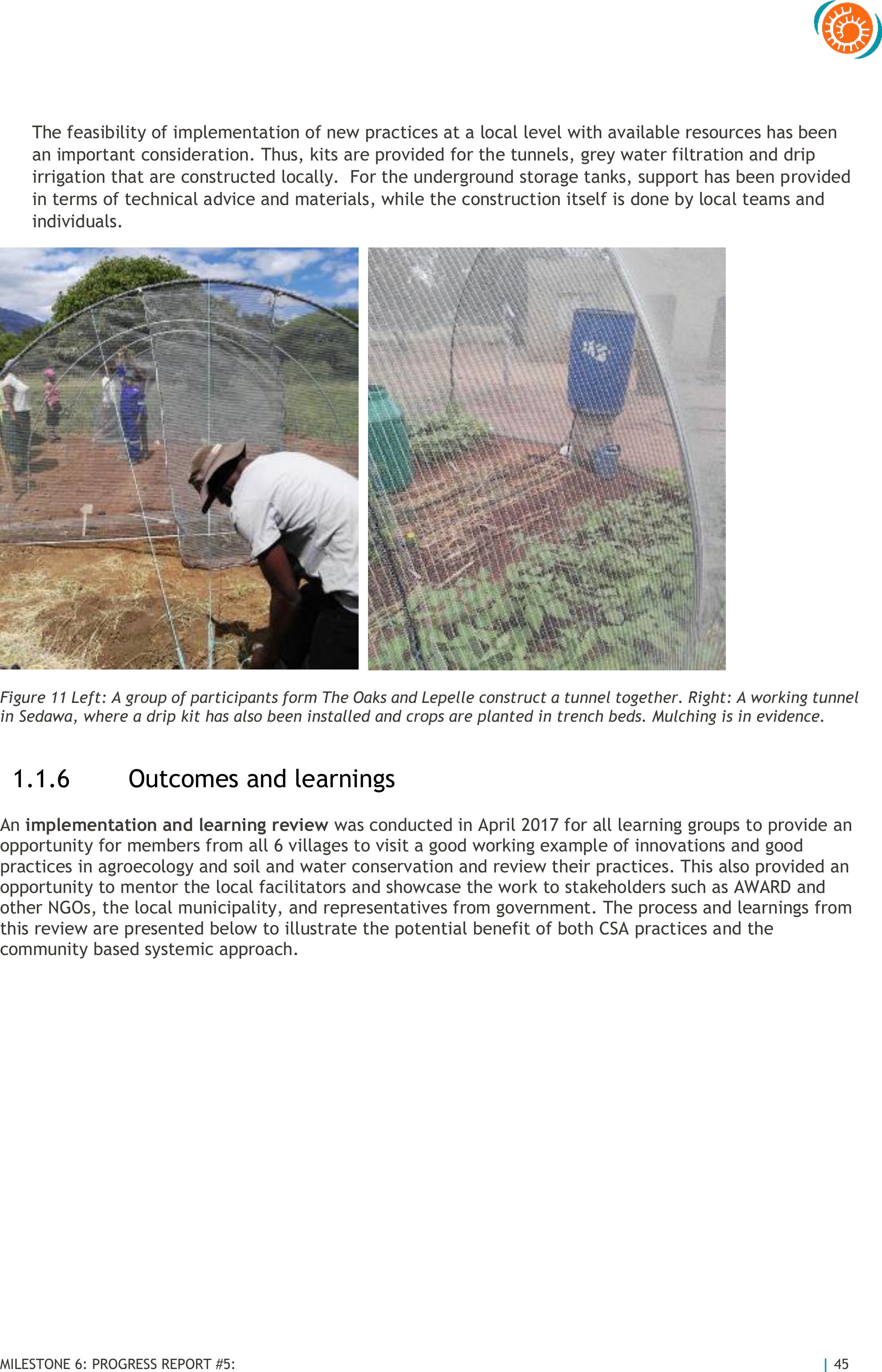
MILESTONE 6: PROGRESS REPORT #5:
| 45
The feasibility of implementation of new practices at a local level with available resources has been
an important consideration. Thus, kits are provided for the tunnels, grey water filtration and drip
irrigation that are constructed locally. For the underground storage tanks, support has been provided
in terms of technical advice and materials, while the construction itself is done by local teams and
individuals.
Figure 11 Left: A group of participants form The Oaks and Lepelle construct a tunnel together. Right: A working tunnel
in Sedawa, where a drip kit has also been installed and crops are planted in trench beds. Mulching is in evidence.
1.1.6Outcomes and learnings
An implementation and learning reviewwas conducted in April 2017 for all learning groups to provide an
opportunity for members from all 6 villages to visit a good working example of innovations and good
practices in agroecology and soil and water conservation and review their practices. This also provided an
opportunity to mentor the local facilitators and showcase the work to stakeholders such as AWARD and
other NGOs, the local municipality, and representatives from government. The process and learnings from
this review are presented below to illustrate the potential benefit of both CSA practices and the
community based systemic approach.

MILESTONE 6: PROGRESS REPORT #5:
| 46
Figure 8 Introduction of facilitators (left) and discussion of practices (right) at implementation review
The definition of the five fingers as broad principles in
good practice for climate change adaptation was reviewed
with the group. Participants named the five fingers
(easily!!) and gave a few brief examples of what they
meant. Good practices were elicited from the group and
then assessed using the traffic light method for how well
they are being implemented by the groups in each village.
We arranged the scale as shown in the box alongside. The
table below describes the outcomes of this exercise.
Participants were fully engaged and really enjoyed this
process.
Table 1: Summary of monitoring assessments for CSA and good
practice implementation by learning group members
Note 1: The percentages in the last column represent the number of participants who indicated they had implemented the practices.
This is indicative only as there were community members present who had not yet been involved as well as a number of visitors.
Note 2: Practices highlighted in light grey are those for which participants felt they needed more input and mentoring.
Principles
Practices
Assessments
(traffic
light)
Percentage implementation
in the group
Water
Management
Cut off drains and swales
Not yet implemented by
most participants
Diversion ditches
~20% (10/52)
Greywater (filtration, use)
~8%
Small dams
~14%
Organic matter (incorporation in soil)-
leaves, bones, woodchips etc buried to
increase water holding and fertility
~60%
Drip irrigation
~6%
Saving water; Rainwater harvesting in
drums, management of leaks of
communal stand pipes, no longer letting
irrigation water run 24/7 - Lepelle
All participants involved in
some way in saving water
Control soil
movement and
erosion
Stone bunds
~24%
Banana basins and circles
~22%
Strip cropping (aloes, sisal) and planting
grass to reduce run-off
~8%
Scale used for assessment of practices
and their implementation
•RED: We know about this but have not done
very much
•YELLOW: We have started implementing
these practices, or a few individuals already
use these, but there is room for expansion
•GREEN: These practices are implemented
by most of the participants.
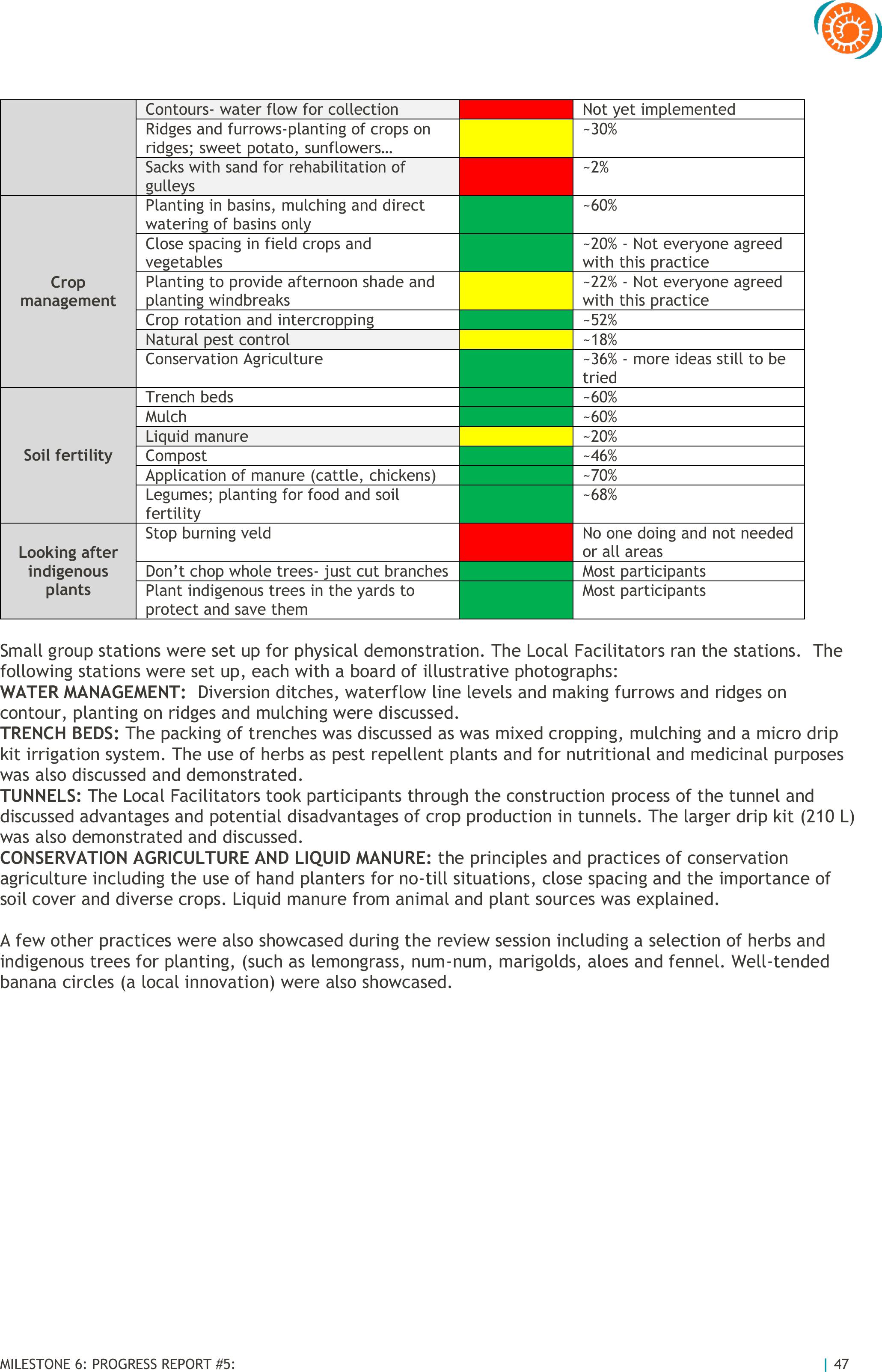
MILESTONE 6: PROGRESS REPORT #5:
| 47
Contours- water flow for collection
Not yet implemented
Ridges and furrows-planting of crops on
ridges; sweet potato, sunflowers…
~30%
Sacks with sand for rehabilitation of
gulleys
~2%
Crop
management
Planting in basins, mulching and direct
watering of basins only
~60%
Close spacing in field crops and
vegetables
~20% - Not everyone agreed
with this practice
Planting to provide afternoon shade and
planting windbreaks
~22% - Not everyone agreed
with this practice
Crop rotation and intercropping
~52%
Natural pest control
~18%
Conservation Agriculture
~36% - more ideas still to be
tried
Soil fertility
Trench beds
~60%
Mulch
~60%
Liquid manure
~20%
Compost
~46%
Application of manure (cattle, chickens)
~70%
Legumes; planting for food and soil
fertility
~68%
Looking after
indigenous
plants
Stop burning veld
No one doing and not needed
or all areas
Don’t chop whole trees- just cut branches
Most participants
Plant indigenous trees in the yards to
protect and save them
Most participants
Small group stations were set up for physical demonstration. The Local Facilitators ran the stations.The
following stations were set up, each with a board of illustrative photographs:
WATER MANAGEMENT:Diversion ditches, waterflow line levels and making furrows and ridges on
contour, planting on ridges and mulching were discussed.
TRENCH BEDS: The packing of trenches was discussed as was mixed cropping, mulching and a micro drip
kit irrigation system. The use of herbs as pest repellent plants and for nutritional and medicinal purposes
was also discussed and demonstrated.
TUNNELS: The Local Facilitators took participants through the construction process of the tunnel and
discussed advantages and potential disadvantages of crop production in tunnels. The larger drip kit (210 L)
was also demonstrated and discussed.
CONSERVATION AGRICULTURE AND LIQUID MANURE: the principles and practices of conservation
agriculture including the use of hand planters for no-till situations, close spacing and the importance of
soil cover and diverse crops. Liquid manure from animal and plant sources was explained.
A few other practices were also showcased during the review session including a selection of herbs and
indigenous trees for planting, (such as lemongrass, num-num, marigolds, aloes and fennel. Well-tended
banana circles (a local innovation) were also showcased.
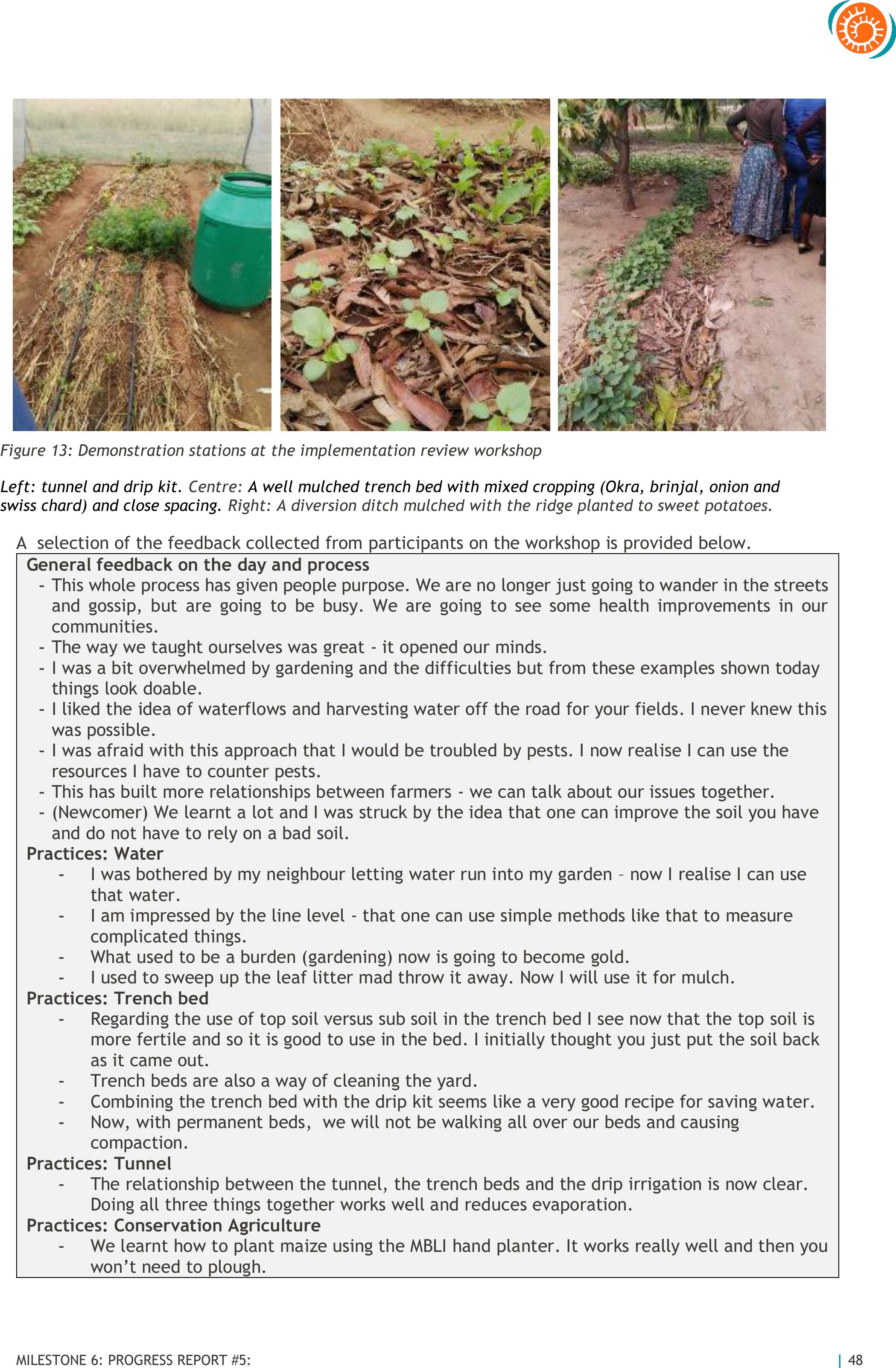
MILESTONE 6: PROGRESS REPORT #5:
| 48
A selection of the feedback collected from participants on the workshop is provided below.
General feedback on the day and process
-This whole process has given people purpose. We are no longer just going to wander in the streets
and gossip, but are going tobe busy. We aregoing to see some health improvements in our
communities.
-The way we taught ourselves was great - it opened our minds.
-I was a bit overwhelmed by gardening and the difficulties but from these examples shown today
things look doable.
-I liked the idea of waterflows and harvesting water off the road for your fields. I never knew this
was possible.
-I was afraid with this approach that I would be troubled by pests. I now realise I can use the
resources I have to counter pests.
-This has built more relationships between farmers - we can talk about our issues together.
-(Newcomer) We learnt a lot and I was struck by the idea that one can improve the soil you have
and do not have to rely on a bad soil.
Practices: Water
-I was bothered by my neighbour letting water run into my garden –now I realise I can use
that water.
-I am impressed by the line level - that one can use simple methods like that to measure
complicated things.
-What used to be a burden (gardening) now is going to become gold.
-I used to sweep up the leaf litter mad throw it away. Now I will use it for mulch.
Practices: Trench bed
-Regarding the use of top soil versus sub soil in the trench bed I see now that the top soil is
more fertile and so it is good to use in the bed. I initially thought you just put the soil back
as it came out.
-Trench beds are also a way of cleaning the yard.
-Combining the trench bed with the drip kit seems like a very good recipe for saving water.
-Now, with permanent beds, we will not be walking all over our beds and causing
compaction.
Practices: Tunnel
-The relationship between the tunnel, the trench beds and the drip irrigation is now clear.
Doing all three things together works well and reduces evaporation.
Practices: Conservation Agriculture
-We learnt how to plant maize using the MBLI hand planter. It works really well and then you
won’t need to plough.
Figure 13: Demonstration stations at the implementation review workshop
Left: tunnel and drip kit. Centre: A well mulched trench bed with mixed cropping (Okra, brinjal, onion and
swiss chard) and close spacing. Right: A diversion ditch mulched with the ridge planted to sweet potatoes.

MILESTONE 6: PROGRESS REPORT #5:
| 49
-I have seen the importance of intercropping for soil cover.
The figure below provides and initial assessment (5 months into a 13 month process) of respondents’
implementation of the new innovations and practices being promoted. This is a work in progress, but
gives an initial indication of new practices introduced that respondents have already implemented and
also in which areas more mentoring would be required.
Figure 14: Implementation of new innovations by a selection of participants in the learning groups (n=34)
Future planning
Activities that were discussed for the winter season included:
-Learning sessions would continue in the various villages and specific attention would be given to
topics participants had highlighted for more attention. A refresher mini-workshop would be held
to include the new participants and bring everyone up to speed. Local facilitators would play an
important role here.
-Local facilitators would begin to visit all participants to support and mentor them and also
monitor their progress with implementation of the innovative practices.
-The winter season when people are at home is a good time to start on the collaborative erosion
control efforts in and around the participants’ homesteads.
-The implementation of a process for participants to access tunnels and drip kits was introduced. In
both cases a limited number of kits can be provided by the implementation team. Participants are
required to show their commitment by digging and packing the required trenches prior to
receiving materials.
-For the piloting of underground RWH tanks it was suggested that participants who do not have
access to municipal water in any form be prioritized. Also volunteers are required to do all the
labour and demonstrate an active interest in gardening to be considered. These criteria were
ratified by the group present as reasonable and acceptable.
0% 10% 20% 30% 40% 50% 60% 70% 80% 90%
Cut off drains
Diversion ditches
Stone bunds
trench beds
Diversified crops
Seed and seedlings
mulching
Contours, line levels
Liquid manure
Green manures, legumes
inter cropping
Nat P&D control
CA
Cut
off
drain
s
Diver
sion
ditch
es
Stone
bunds
trenc
h
beds
Diver
sified
crops
Seed
and
seedli
ngs
mulc
hing
Conto
urs,
line
levels
Liqui
d
manu
re
Gree
n
manu
res,
legu
mes
inter
cropp
ing
Nat
P&D
contr
ol
CA
% implmentation of new innovations12% 21% 29% 24% 82% 50% 44%3%6%29% 32%3%50%
New innovations -April 2017 (n=34)
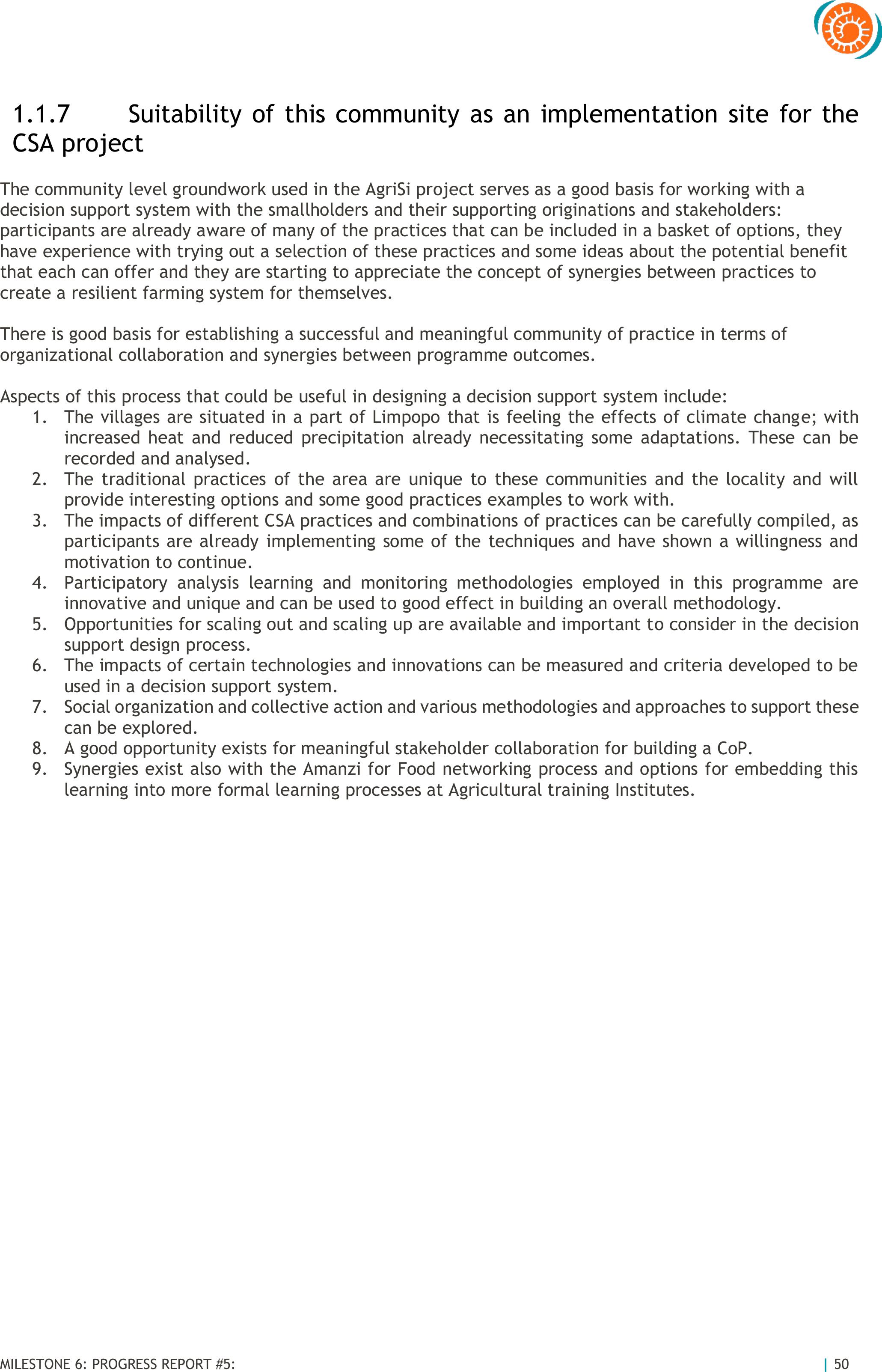
MILESTONE 6: PROGRESS REPORT #5:
| 50
1.1.7Suitability of this community as an implementation site for the
CSA project
The community level groundwork used in the AgriSi project serves as a good basis for working with a
decision support system with the smallholders and their supporting originations and stakeholders:
participants are already aware of many of the practices that can be included in a basket of options, they
have experience with trying out a selection of these practices and some ideas about the potential benefit
that each can offer and they are starting to appreciate the concept of synergies between practices to
create a resilient farming system for themselves.
There is good basis for establishing a successful and meaningful community of practice in terms of
organizational collaboration and synergies between programme outcomes.
Aspects of this process that could be useful in designing a decision support system include:
1. The villages are situated in a part of Limpopo that isfeeling the effects of climate change; with
increased heat and reduced precipitation already necessitating some adaptations. These can be
recorded and analysed.
2. The traditional practices of the area are unique tothese communities and the locality and will
provide interesting options and some good practices examples to work with.
3. The impacts of different CSA practices and combinations of practices can be carefully compiled, as
participants are already implementing some of the techniques and have shown a willingness and
motivation to continue.
4. Participatory analysis learning and monitoring methodologies employed in this programme are
innovative and unique and can be used to good effect in building an overall methodology.
5. Opportunities for scaling out and scaling up are available and important to consider in the decision
support design process.
6. The impacts of certain technologies and innovations can be measured and criteria developed to be
used in a decision support system.
7. Social organization and collective action and various methodologies and approaches tosupport these
can be explored.
8. A good opportunity exists for meaningful stakeholder collaboration for building a CoP.
9. Synergies exist also with the Amanzi for Food networking process and options for embedding this
learning into more formal learning processes at Agricultural training Institutes.
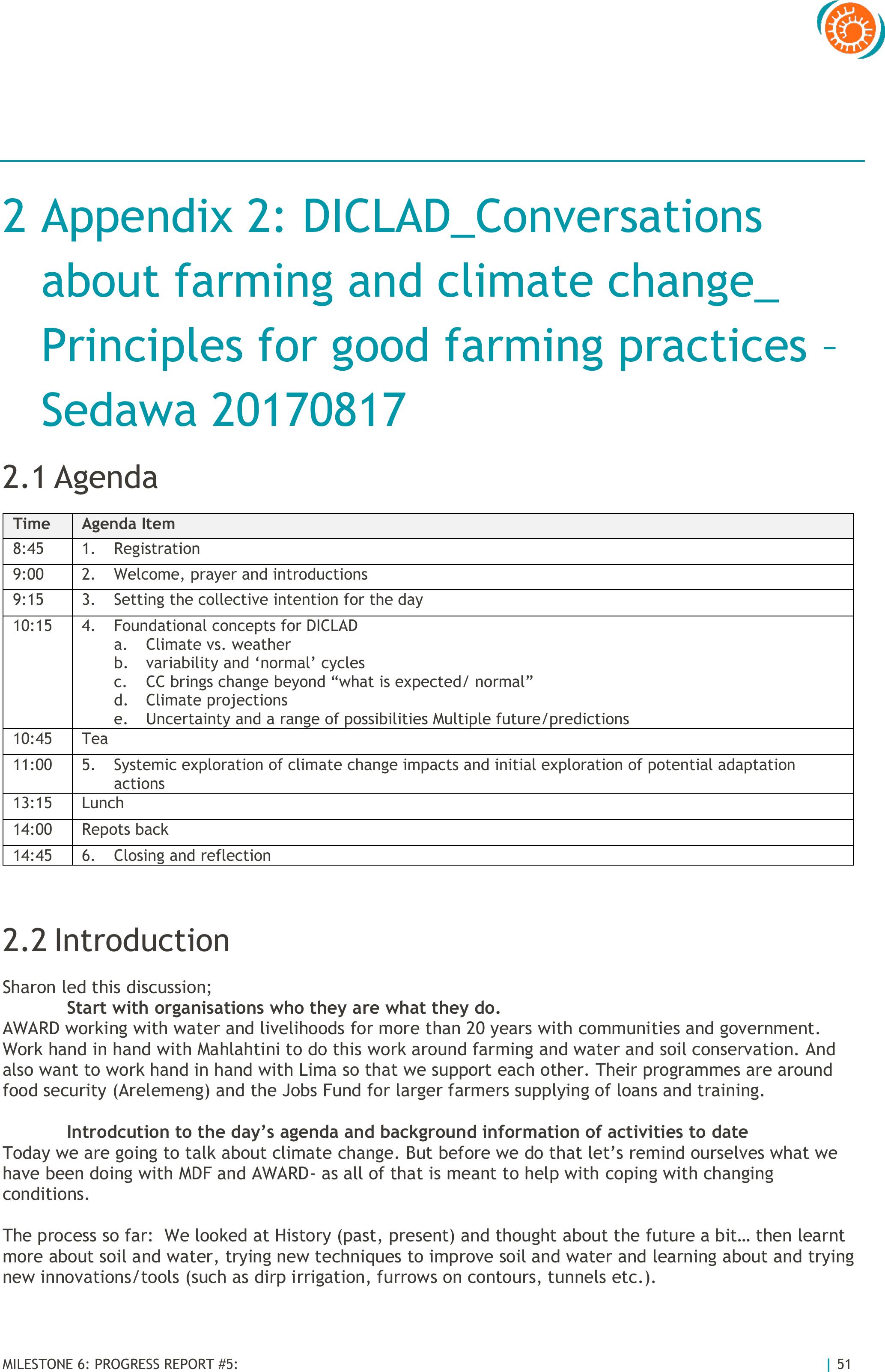
MILESTONE 6: PROGRESS REPORT #5:
| 51
2 Appendix 2: DICLAD_Conversations
about farming and climate change_
Principles for good farming practices –
Sedawa 20170817
2.1 Agenda
Time
Agenda Item
8:45
1. Registration
9:00
2. Welcome, prayer and introductions
9:15
3. Setting the collective intention for the day
10:15
4. Foundational concepts for DICLAD
a. Climate vs. weather
b. variability and ‘normal’ cycles
c. CC brings change beyond “what is expected/ normal”
d. Climate projections
e. Uncertainty and a range of possibilities Multiple future/predictions
10:45
Tea
11:00
5. Systemic exploration of climate change impacts and initial exploration of potential adaptation
actions
13:15
Lunch
14:00
Repots back
14:45
6. Closing and reflection
2.2 Introduction
Sharon led this discussion;
Start with organisations who they are what they do.
AWARD working with water and livelihoods for more than 20 years with communities and government.
Work hand in hand with Mahlahtini to do this work around farming and water and soil conservation. And
also want to work hand in hand with Lima so that we support each other. Their programmes are around
food security (Arelemeng) and the Jobs Fund for larger farmers supplying of loans and training.
Introdcution to the day’s agenda and background information of activities to date
Today we are going to talk about climate change. But before we do that let’s remind ourselves what we
have been doing with MDF and AWARD- as all of that is meant to help withcoping with changing
conditions.
The process so far: We looked at History (past, present) and thought about the future a bit… then learnt
more about soil and water, trying new techniques to improve soil and water and learning about and trying
new innovations/tools (such as dirp irrigation, furrows on contours, tunnels etc.).
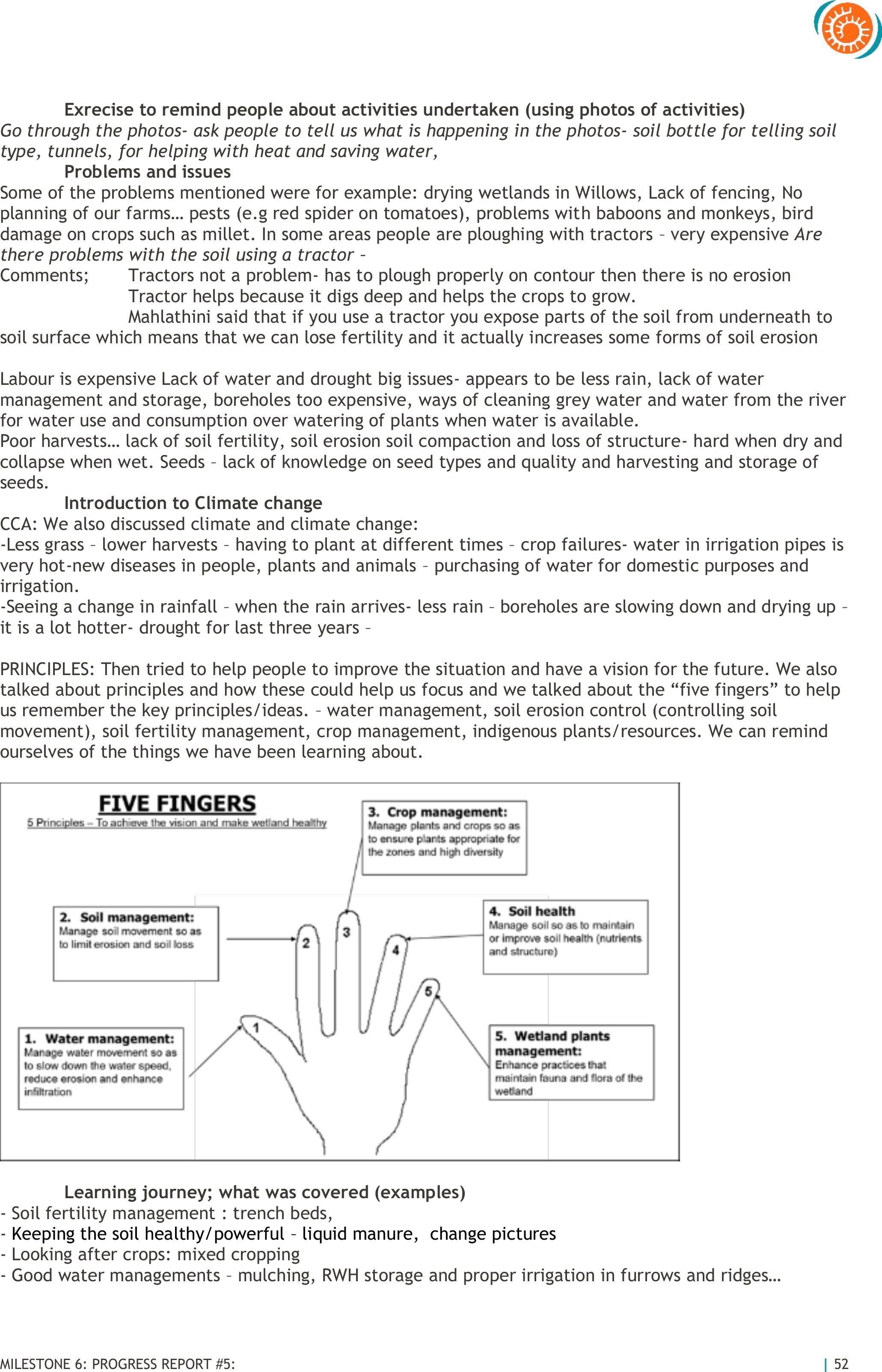
MILESTONE 6: PROGRESS REPORT #5:
| 52
Exrecise to remind people about activities undertaken (using photos of activities)
Go through the photos- ask people to tell us what is happening in the photos- soil bottle for telling soil
type, tunnels, for helping with heat and saving water,
Problems and issues
Some of the problems mentioned were for example: drying wetlands in Willows, Lack of fencing, No
planning of our farms… pests (e.g red spider on tomatoes), problems with baboons and monkeys, bird
damage on crops such as millet. In some areas people are ploughing with tractors –very expensive Are
there problems with the soil using a tractor –
Comments; Tractors not a problem-has to plough properly on contour then there is no erosion
Tractor helps because it digs deep and helps the crops to grow.
Mahlathini said that if you use a tractor you expose parts of the soil from underneath to
soil surface which means that we can lose fertility and it actually increases someforms of soil erosion
Labour is expensive Lack of water and drought big issues- appears to be less rain, lack of water
management and storage, boreholes too expensive, ways of cleaning grey water and water from the river
for water use and consumption over watering of plants when water is available.
Poor harvests… lack of soil fertility, soil erosion soil compaction and loss of structure- hard when dry and
collapse when wet. Seeds –lack of knowledge on seed types and quality and harvesting and storage of
seeds.
Introduction to Climate change
CCA: We also discussed climate and climate change:
-Less grass –lower harvests –having to plant at different times –crop failures- water in irrigation pipes is
very hot-new diseases in people, plants and animals –purchasing of water for domestic purposes and
irrigation.
-Seeing a change in rainfall –when the rain arrives- less rain –boreholes are slowing down and drying up –
it is a lot hotter- drought for last three years –
PRINCIPLES: Then tried to help people to improve the situation and have a vision for the future. We also
talked about principles and how these could help us focus and we talked about the “five fingers” to help
us remember the key principles/ideas. –water management, soil erosion control (controlling soil
movement), soil fertility management, crop management, indigenous plants/resources. We can remind
ourselves of the things we have been learning about.
Learning journey; what was covered (examples)
- Soil fertility management : trench beds,
- Keeping the soil healthy/powerful –liquid manure, change pictures
- Looking after crops: mixed cropping
- Good water managements – mulching, RWH storage and proper irrigation in furrows and ridges…
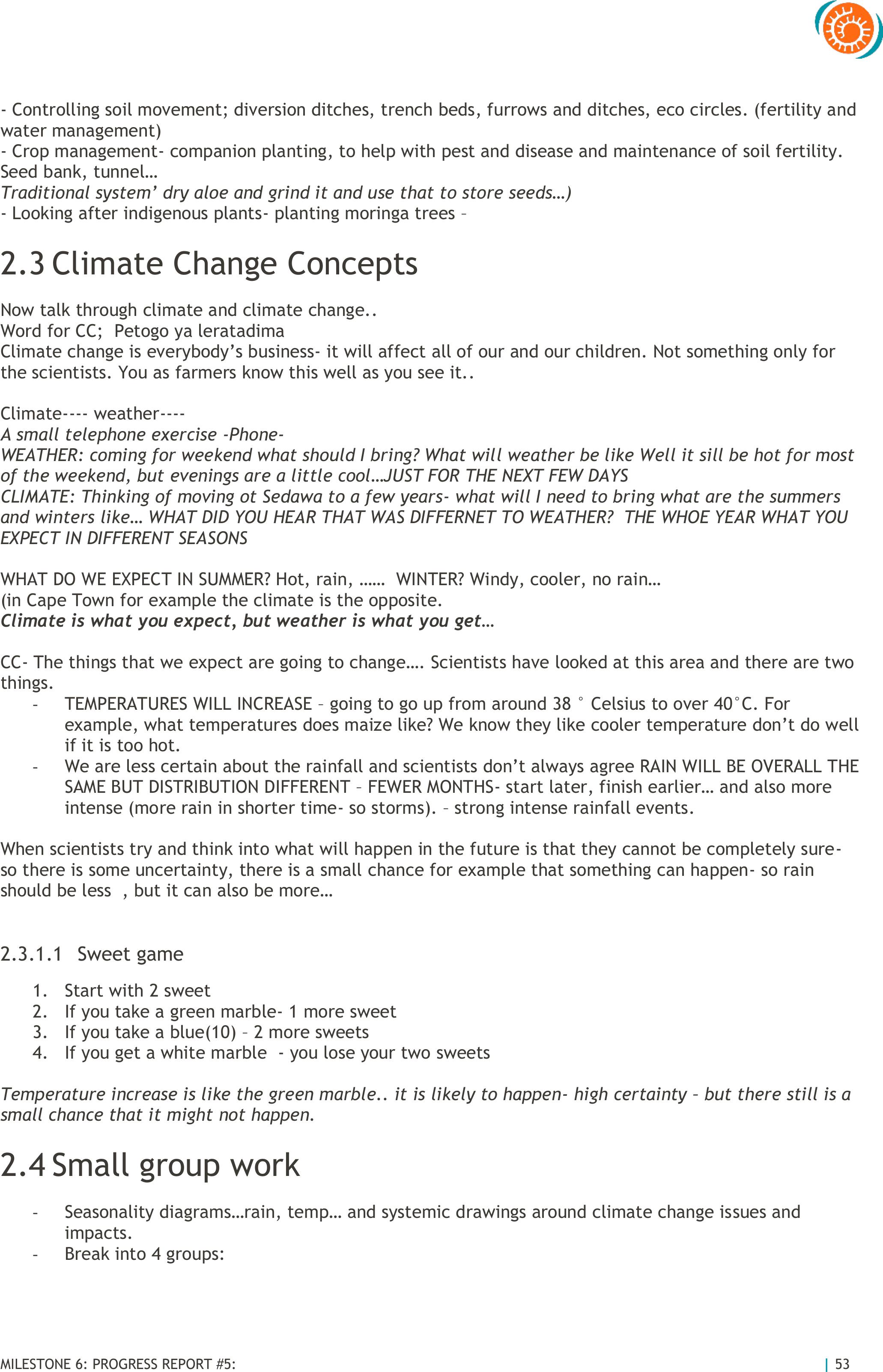
MILESTONE 6: PROGRESS REPORT #5:
| 53
- Controlling soil movement; diversion ditches, trench beds, furrows and ditches, eco circles. (fertility and
water management)
- Crop management- companion planting, to help with pest and disease and maintenance of soil fertility.
Seed bank, tunnel…
Traditional system’ dry aloe and grind it and use that to store seeds…)
- Looking after indigenous plants- planting moringa trees –
2.3Climate Change Concepts
Now talk through climate and climate change..
Word for CC; Petogo ya leratadima
Climate change is everybody’s business- it will affect all of our and our children. Not something only for
the scientists. You as farmers know this well as you see it..
Climate---- weather----
A small telephone exercise -Phone-
WEATHER: coming for weekend what should I bring? What will weather be like Well it sill be hot for most
of the weekend, but evenings are a little cool…JUST FOR THE NEXT FEW DAYS
CLIMATE: Thinking of moving ot Sedawa to a few years- what will I need to bring what are the summers
and winters like… WHAT DID YOU HEAR THAT WAS DIFFERNET TO WEATHER? THE WHOE YEAR WHAT YOU
EXPECT IN DIFFERENT SEASONS
WHAT DO WE EXPECT IN SUMMER? Hot, rain, …… WINTER? Windy, cooler, no rain…
(in Cape Town for example the climate is the opposite.
Climate is what you expect, but weather is what you get…
CC-The things that we expect are going to change…. Scientists have looked at this area and there are two
things.
-TEMPERATURES WILL INCREASE –going to go up from around 38 ° Celsius to over 40°C. For
example, what temperatures does maize like? We know they like cooler temperature don’t do well
if it is too hot.
-We are less certain about the rainfall and scientists don’t always agree RAIN WILL BE OVERALL THE
SAME BUT DISTRIBUTION DIFFERENT –FEWER MONTHS- start later, finish earlier… and also more
intense (more rain in shorter time- so storms). –strong intense rainfall events.
When scientists try and think into what will happen in the future is that they cannot be completely sure-
so there is some uncertainty, there is a small chance for example that something can happen- so rain
should be less , but it can also be more…
2.3.1.1Sweet game
1. Start with 2 sweet
2. If you take a green marble-1 more sweet
3. If you take a blue(10) –2 more sweets
4. If you get a white marble - you lose your twosweets
Temperature increase is like the green marble.. it is likely to happen- high certainty –but there still is a
small chance that it might not happen.
2.4Small group work
-Seasonality diagrams…rain, temp… and systemic drawings around climate change issues and
impacts.
-Break into 4 groups:
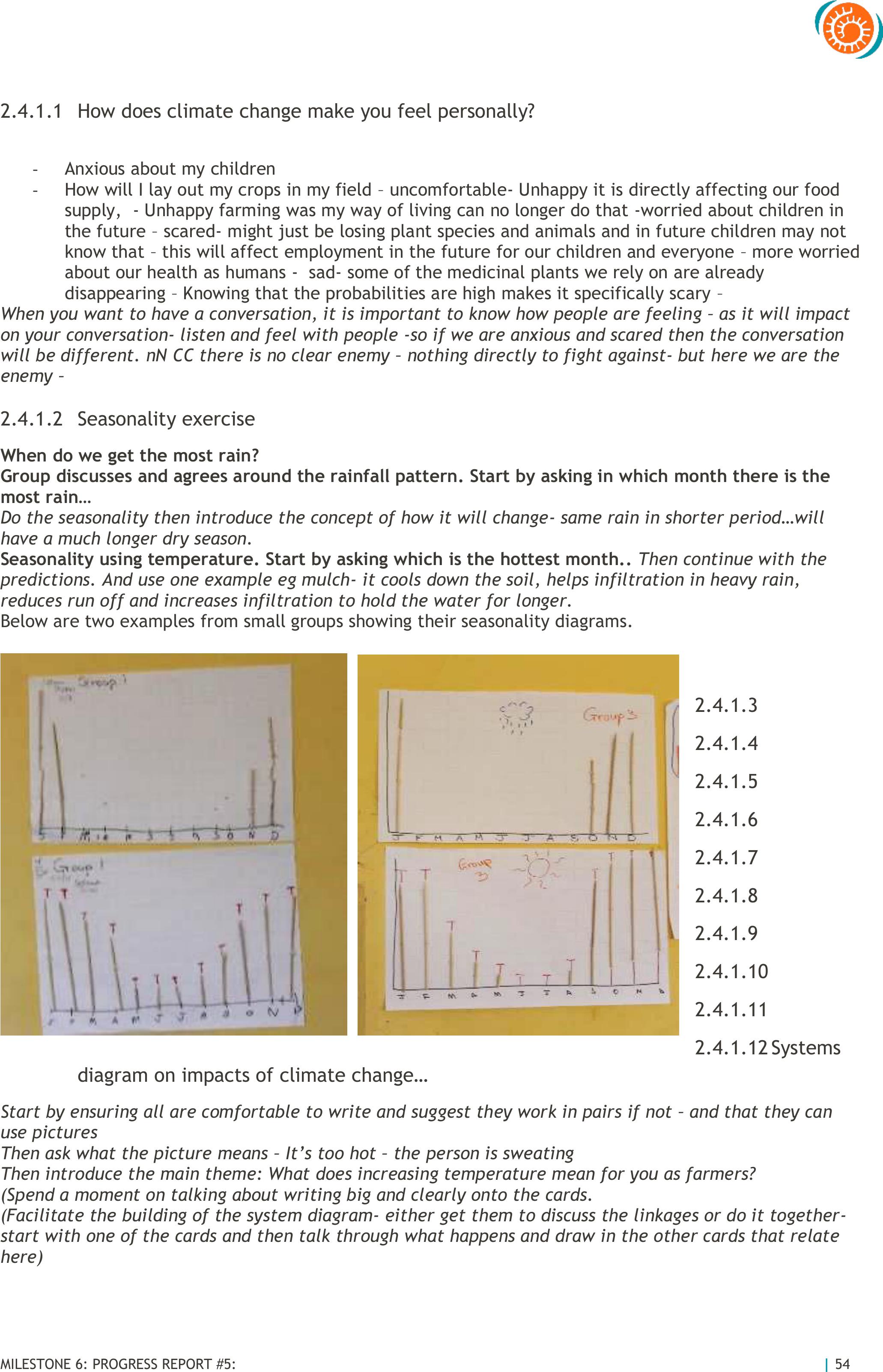
MILESTONE 6: PROGRESS REPORT #5:
| 54
2.4.1.1How does climate change make you feel personally?
-Anxious about my children
-How will I lay out my crops in my field –uncomfortable- Unhappy it is directly affecting our food
supply, - Unhappy farming was my way of living can no longer do that -worried about children in
the future –scared- might just be losing plant species and animals and in future children may not
know that –this will affect employment in the future for our children and everyone –more worried
about our health as humans -sad- some of the medicinal plants we rely on are already
disappearing –Knowing that the probabilities are high makes it specifically scary –
When you want to have a conversation, it is important to know how people are feeling –as it will impact
on your conversation- listen and feel with people -so if we are anxious and scared then the conversation
will be different. nN CC there is no clear enemy –nothing directly to fight against- but here we are the
enemy –
2.4.1.2Seasonality exercise
When do we get the most rain?
Group discusses and agrees around the rainfall pattern. Start by asking in which month there is the
most rain…
Do the seasonality then introduce the concept of how it will change- same rain in shorter period…will
have a much longer dry season.
Seasonality using temperature. Start by asking which is the hottest month..Then continue with the
predictions. And use one example eg mulch- it cools down the soil, helps infiltration in heavy rain,
reduces run off and increases infiltration to hold the water for longer.
Below are two examples from small groups showing their seasonality diagrams.
2.4.1.3
2.4.1.4
2.4.1.5
2.4.1.6
2.4.1.7
2.4.1.8
2.4.1.9
2.4.1.10
2.4.1.11
2.4.1.12Systems
diagram on impacts of climate change…
Start by ensuring all are comfortable to write and suggest they work in pairs if not –and that they can
use pictures
Then ask what the picture means – It’s too hot – the person is sweating
Then introduce the main theme: What does increasing temperature mean for you as farmers?
(Spend a moment on talking about writing big and clearly onto the cards.
(Facilitate the building of the system diagram- either get them to discuss the linkages or do it together-
start with one of the cards and then talk through what happens and draw in the other cards that relate
here)

MILESTONE 6: PROGRESS REPORT #5:
| 55
(Explore causality start with something then explore what happens then eg crop failure- leads to famine-
leads to malnutrition – which then also gets into the issues that CC are not just a farmer’s problem -it
affects everyone- including doctors and nurses
-Crop Failure, With the high temperatures even if you have irrigation it will still not help that
much. And then also the rainfall will be severe and
-Soil will be hotter and crops will wilt faster...The water for irrigation is also hotter… there is
more evaporation… ( in dams we can lose nearly all the water to evaporation so under CC open
dams are not such a good idea. –even small tanks open to the sun will lose a lot of water )(Higher
evaporation means less water) –talk through this to get to less water in the rivers, boreholes
etc.. Ask why is borehole water going down? They believe because the soil is hot and the
recharge does not get down into the soil and also the water table drops… that’s why people drill
boreholes in the dry season, because then it is at the lowest. How does water get into the
boreholes/ underground? Through the river and the rain but the rain is intense –so it does not
infiltrate well -it runs off. When you talk about crop failure –is it all crops? Or Certain crops? .
there are some plants that are drought resistant, For example ibece, beetroot, onions,
groundnuts, cowpeas, sorghum, millet. Susceptible are tomatoes, beans, pumpkins, jugo beans,
cabbage, Chinese cabbage, bananas….
-What will crop failure lead to? Lack of food- famine -then lack of food leads to lack of nutrition,
increased diseases in humans, but also in plants- when your crops are weak they are more
susceptible and plants that are water stressed also get more diseases…It is more of an immune
system thing and it also affects humans –also when it is dry the only green plants are the ones in
your garden and so they are under increased pest attack…..What does lack of food lead to also –
no jobs- then what happens if there are no jobs –people steal or move away or die
Then at some stage hand over to the group to draw in the linkages – draw in arrows… then look at this
and see whether there are any feedback loops and talk through these circles that are self re-enforcing
and very dangerous
2.4.1.12.1Relate the impacts related to farming and think through possible solutions.
Mark the farming ones, the water ones, the health ones, the economy ones etc…Draw circles around the
themes and show the climate change will affect all the different things –water, farming health,
society…So as farmers you have a very central role in holding all of these things together…
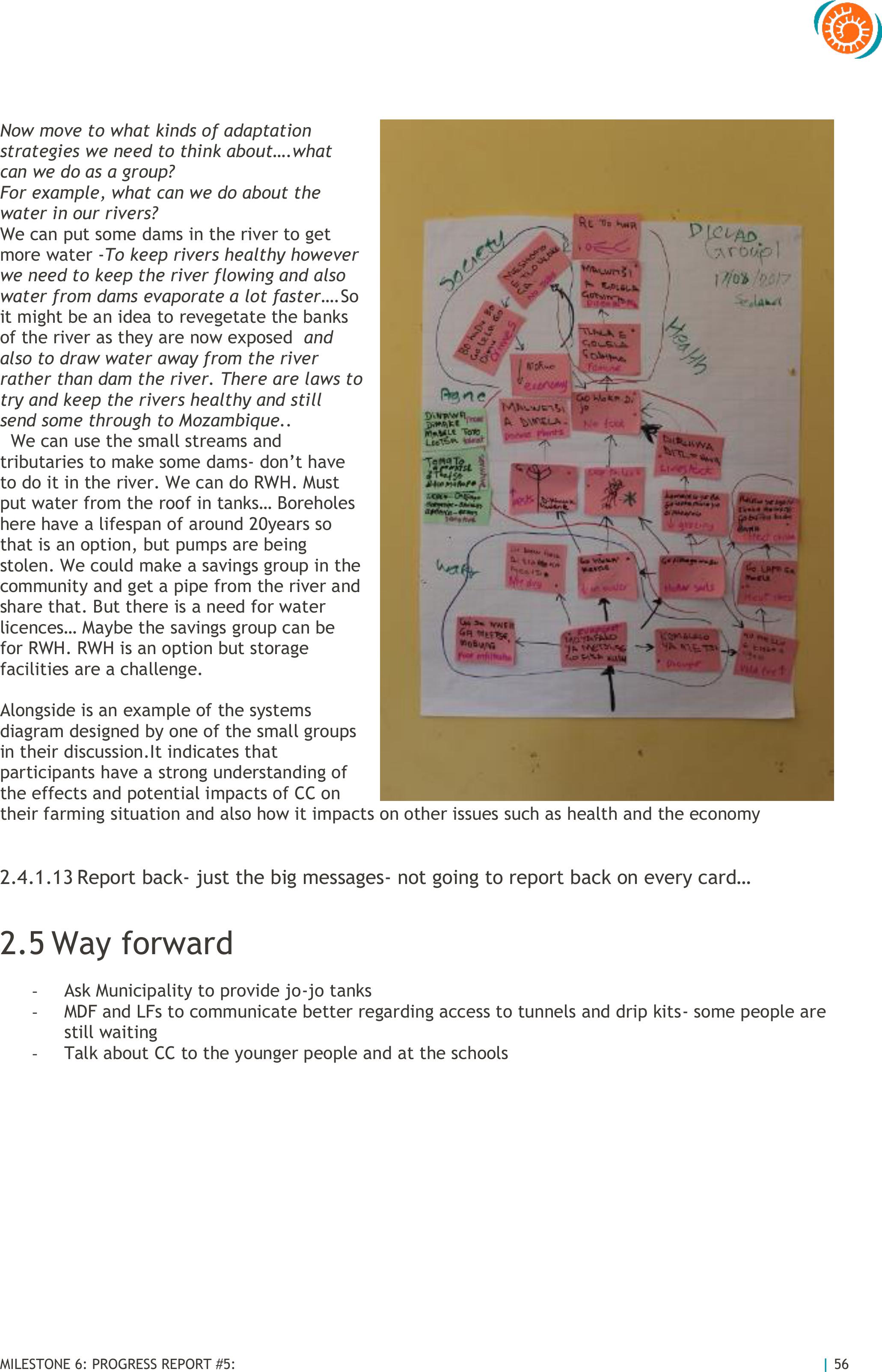
MILESTONE 6: PROGRESS REPORT #5:
| 56
Now move to what kinds of adaptation
strategies we need to think about….what
can we do as a group?
For example, what can we do about the
water in our rivers?
We can put some dams in the river to get
more water -To keep rivers healthy however
we need to keep the river flowing and also
water from dams evaporate a lot faster….So
it might be an idea to revegetate the banks
of the river as they are now exposed and
also to draw water away from the river
rather than dam the river. There are laws to
try and keep the rivers healthy and still
send some through to Mozambique..
We can use the small streams and
tributaries to make some dams- don’t have
to do it in the river. We can do RWH. Must
put water from the roof in tanks… Boreholes
here have a lifespan of around 20years so
that is an option, but pumps are being
stolen. We could make a savings group in the
community and get a pipe from the river and
share that. But there is a need for water
licences… Maybe the savings group can be
for RWH. RWH is an option but storage
facilities are a challenge.
Alongside is an example of the systems
diagram designed by one of the small groups
in their discussion.It indicates that
participants have a strong understanding of
the effects and potential impacts of CC on
their farming situation and also how it impacts on other issues such as health and the economy
2.4.1.13Report back- just the big messages- not going to report back on every card…
2.5Way forward
-Ask Municipality to provide jo-jo tanks
-MDF and LFs to communicate better regarding access to tunnels and drip kits- some people are
still waiting
-Talk about CC to the younger people and at the schools